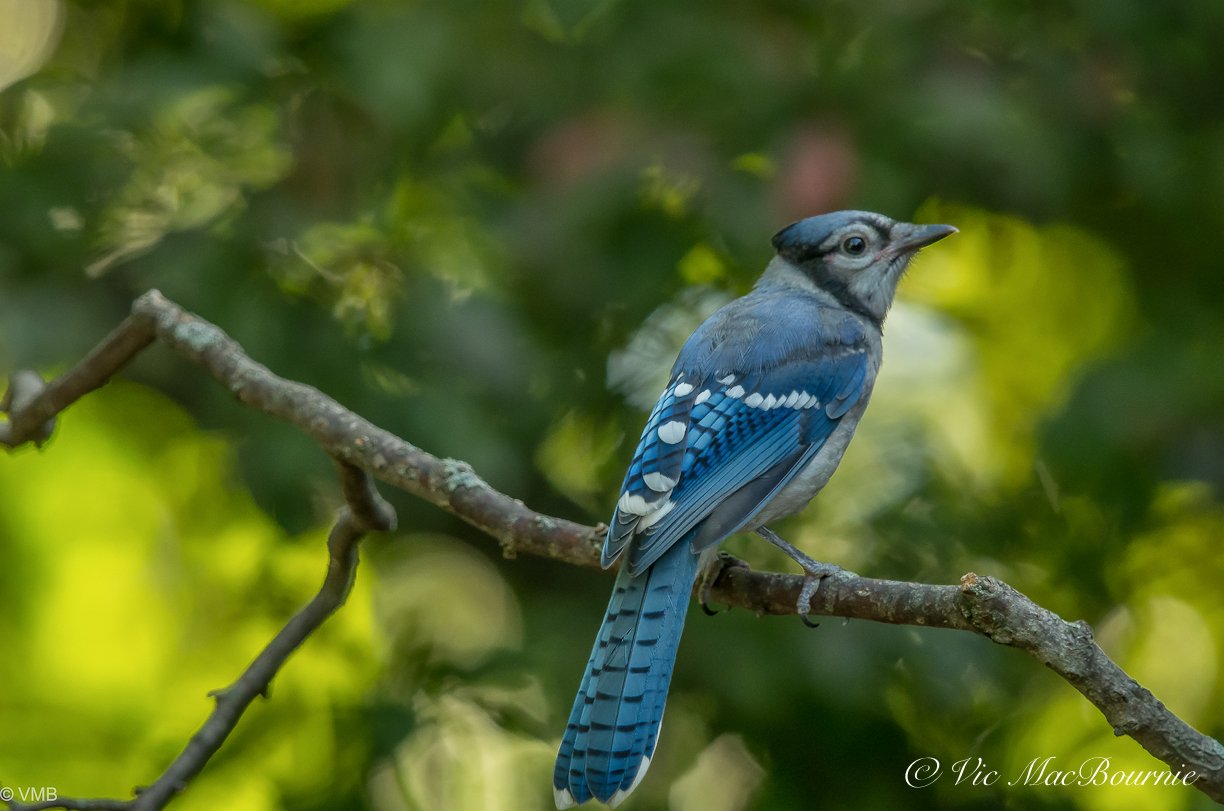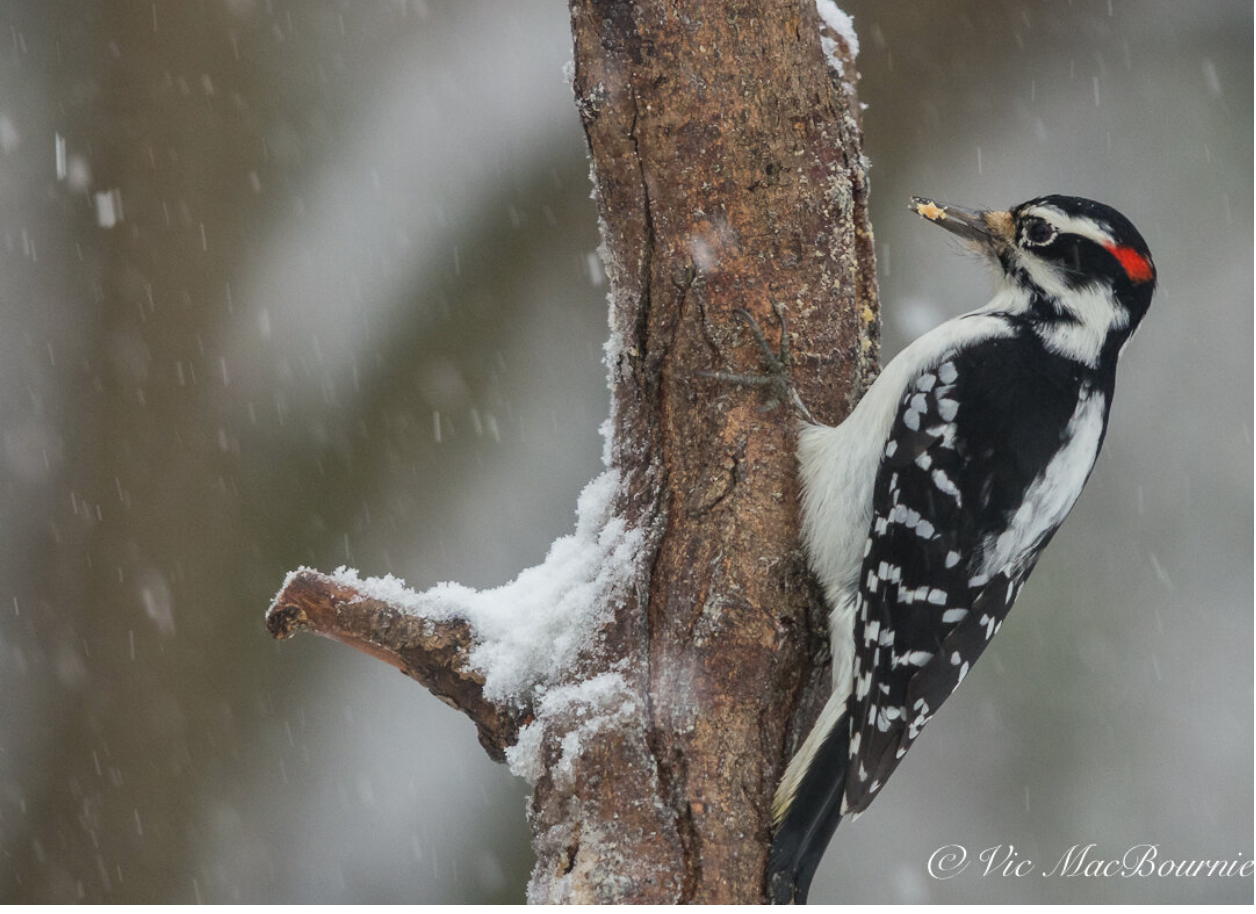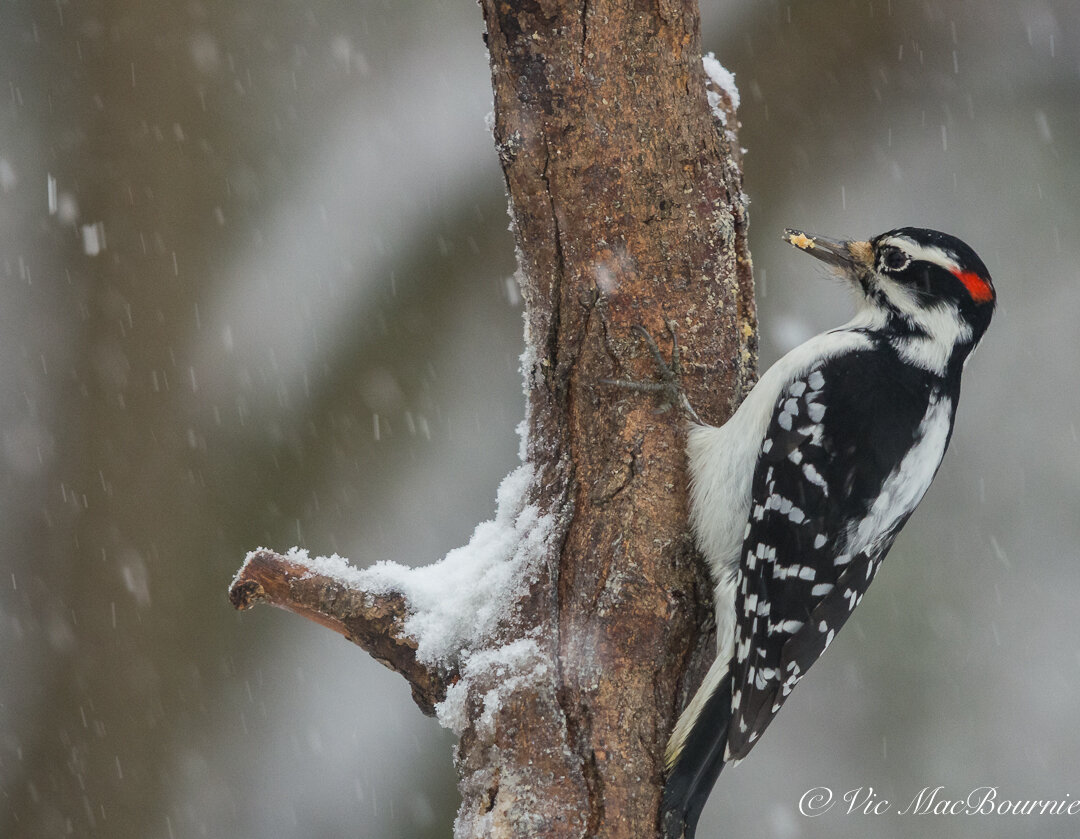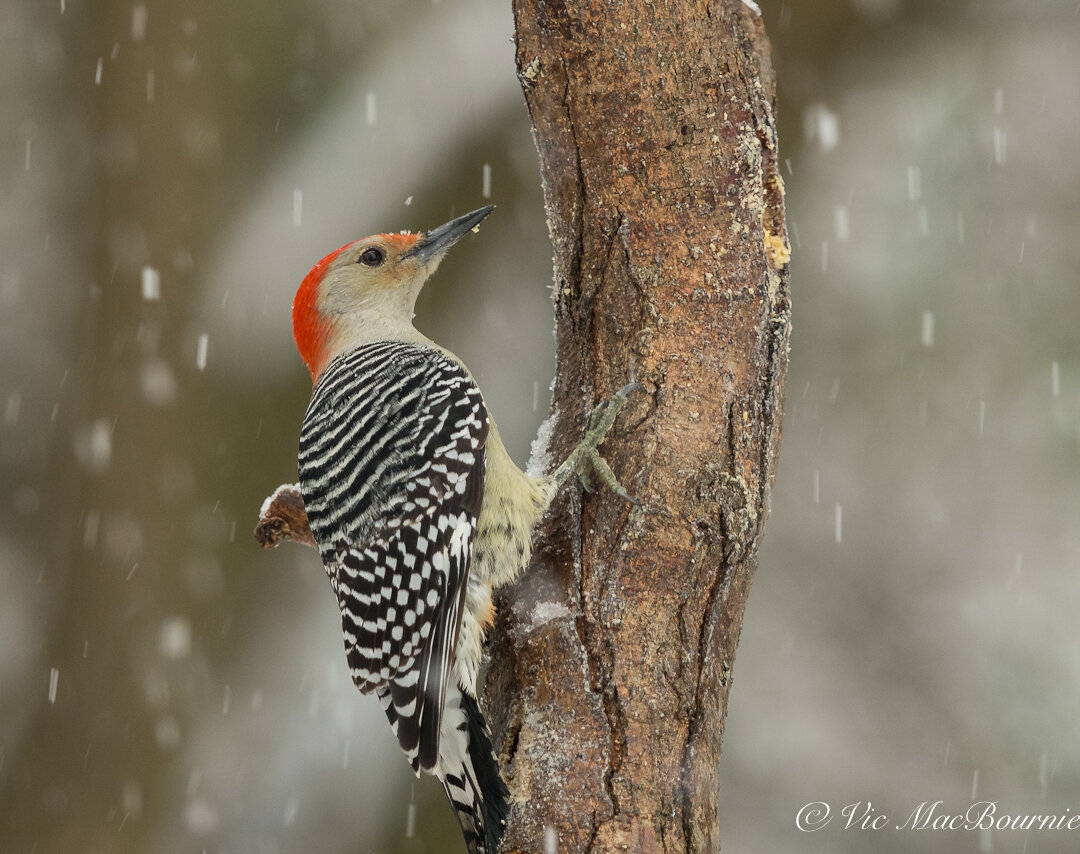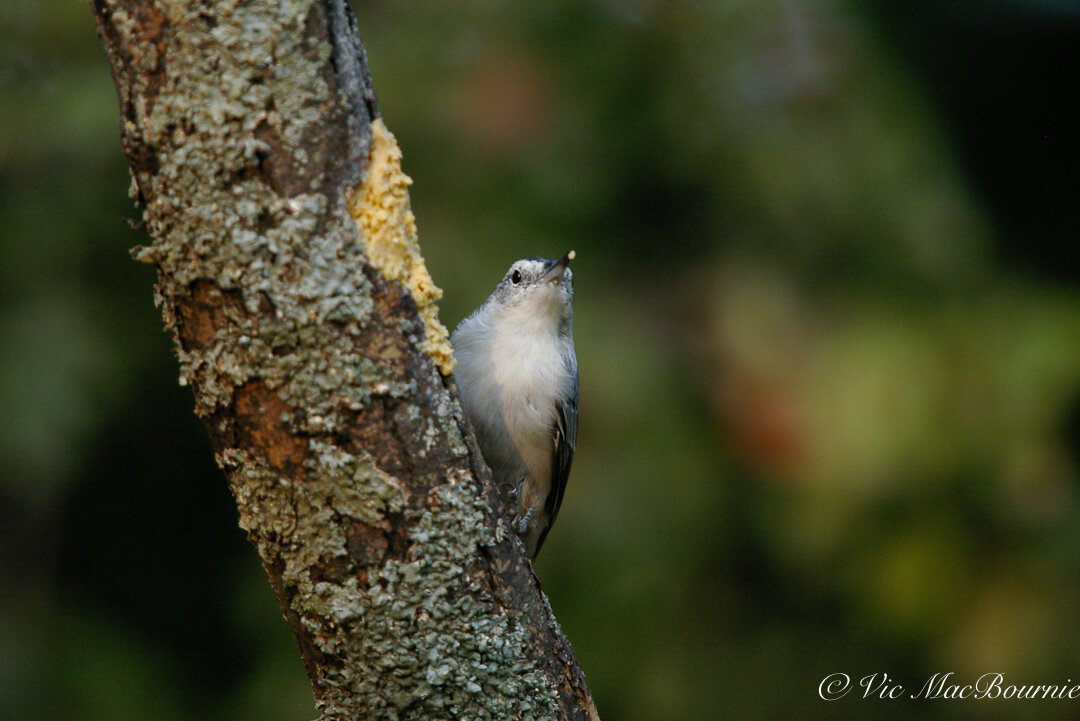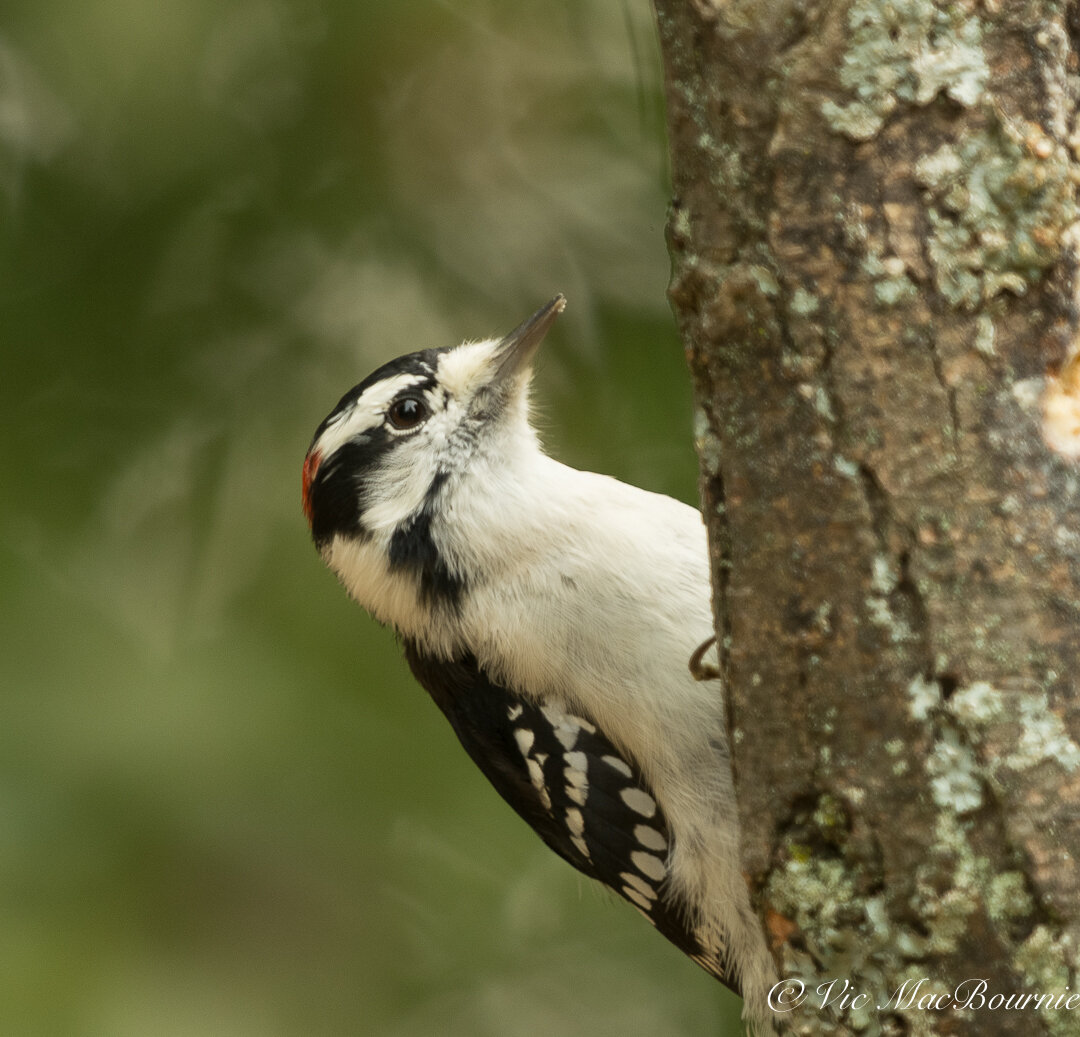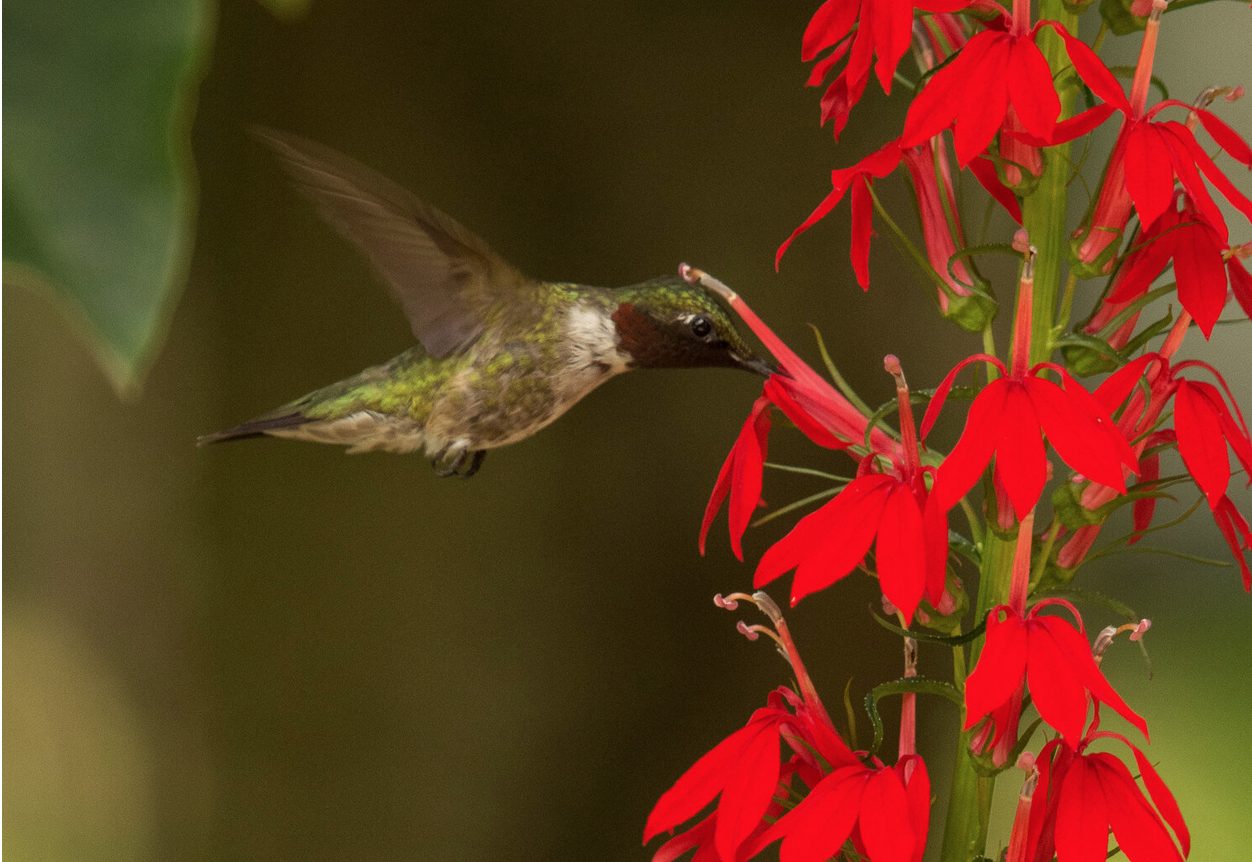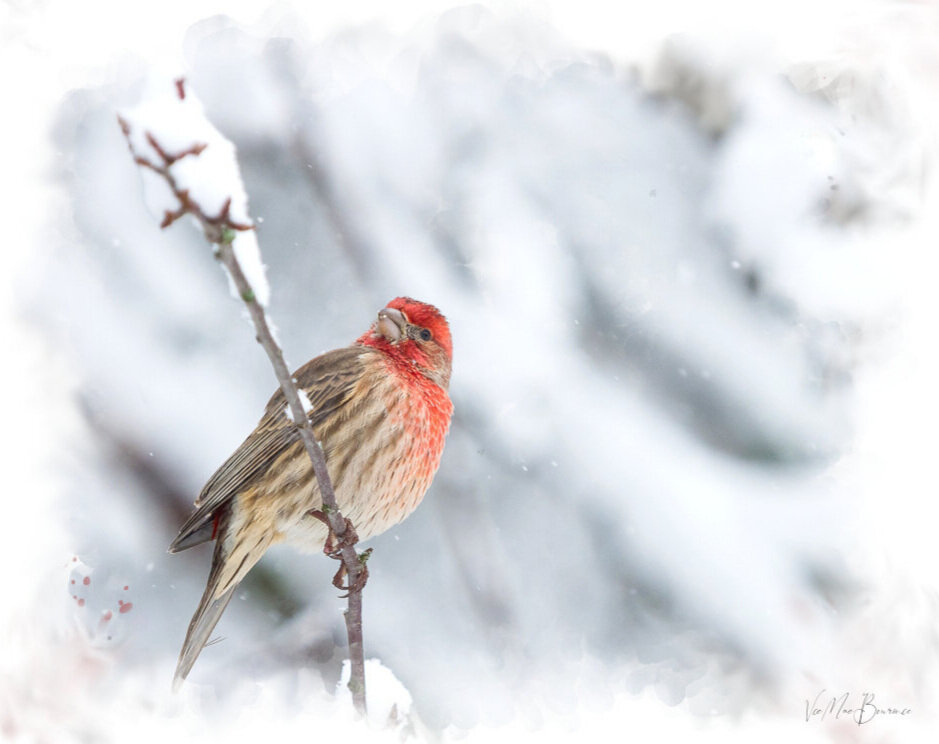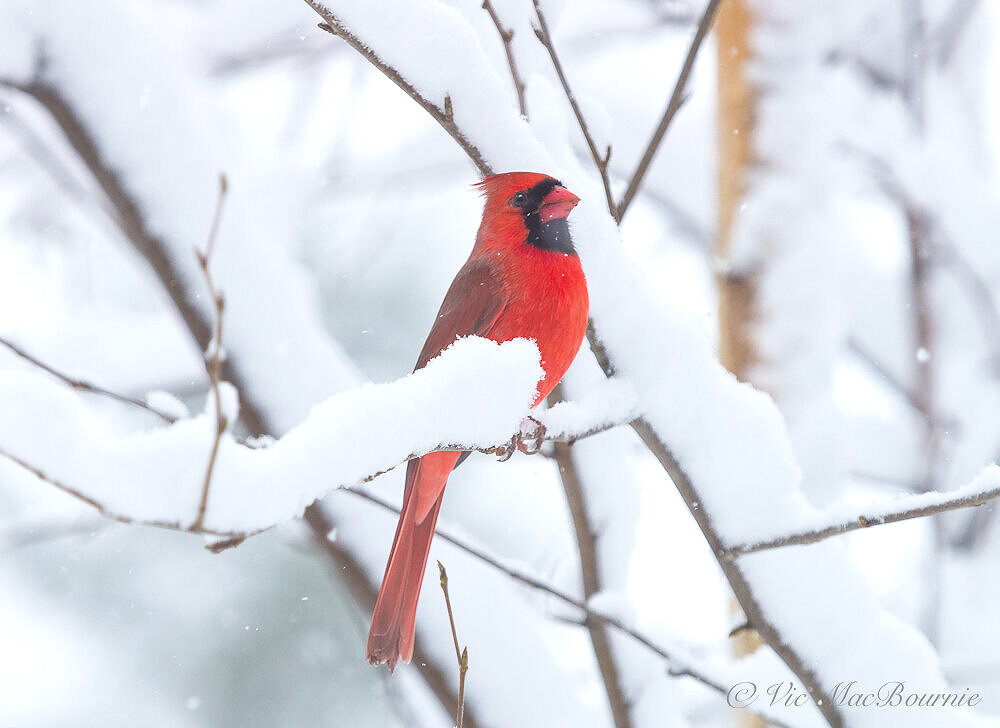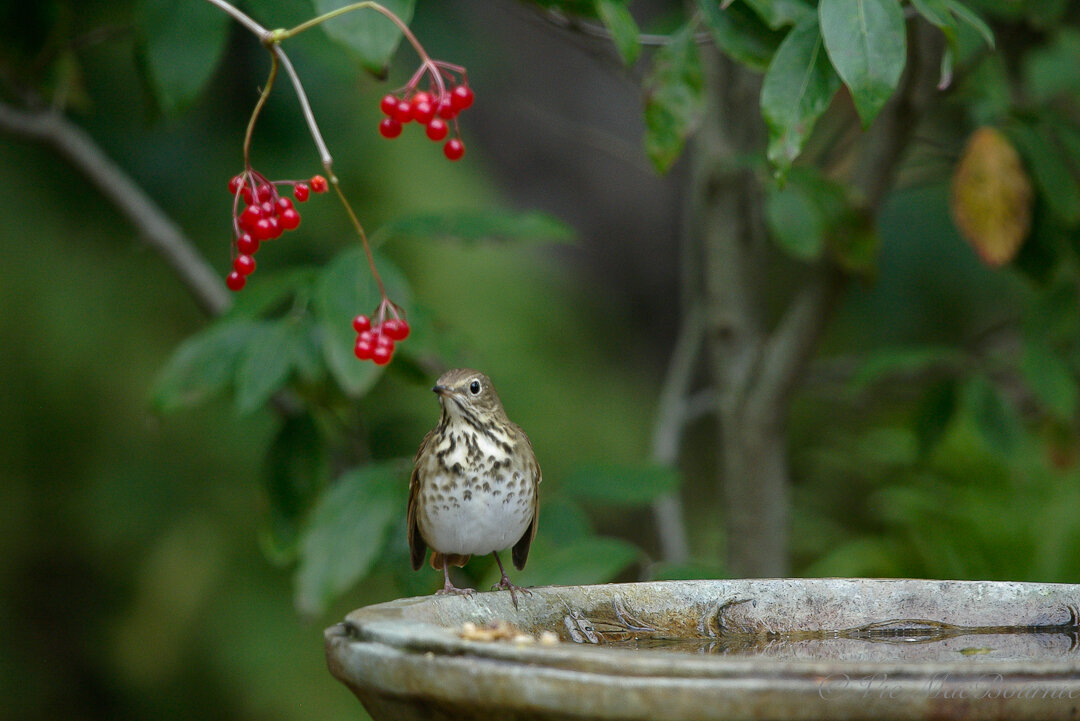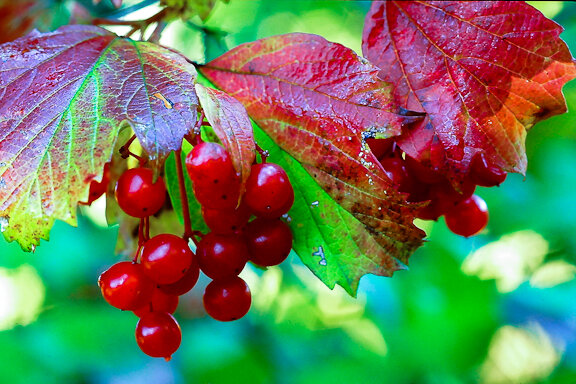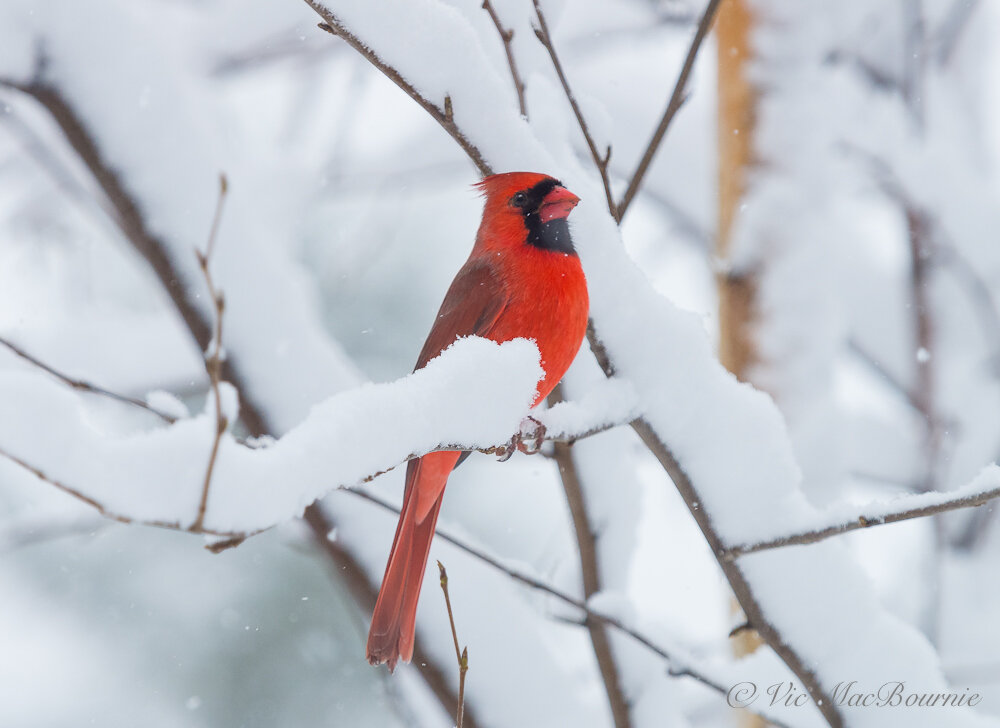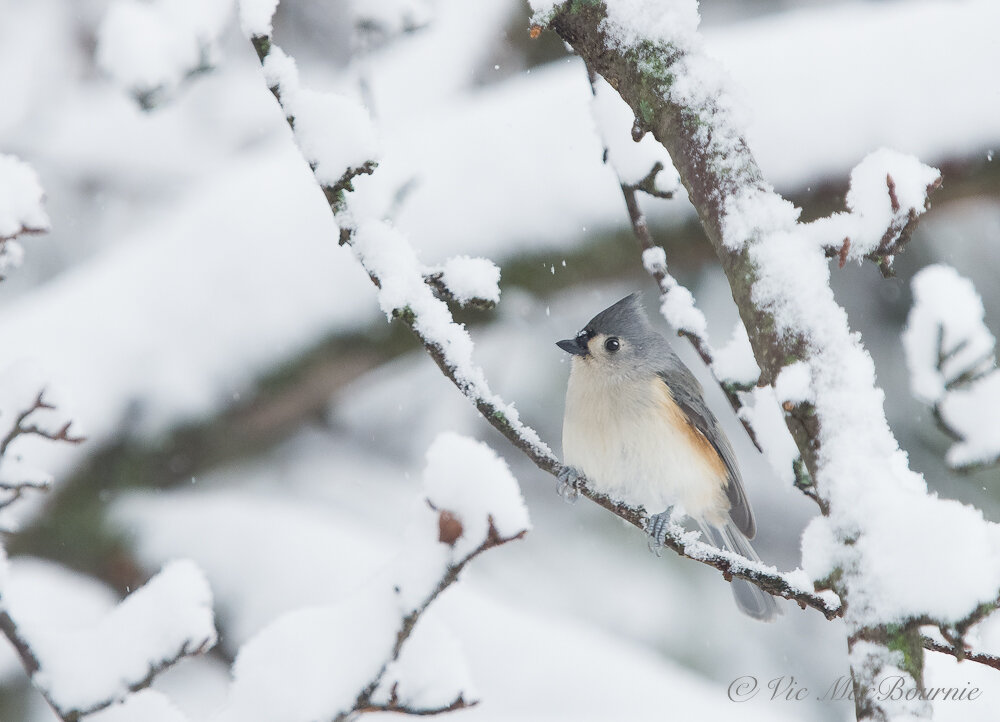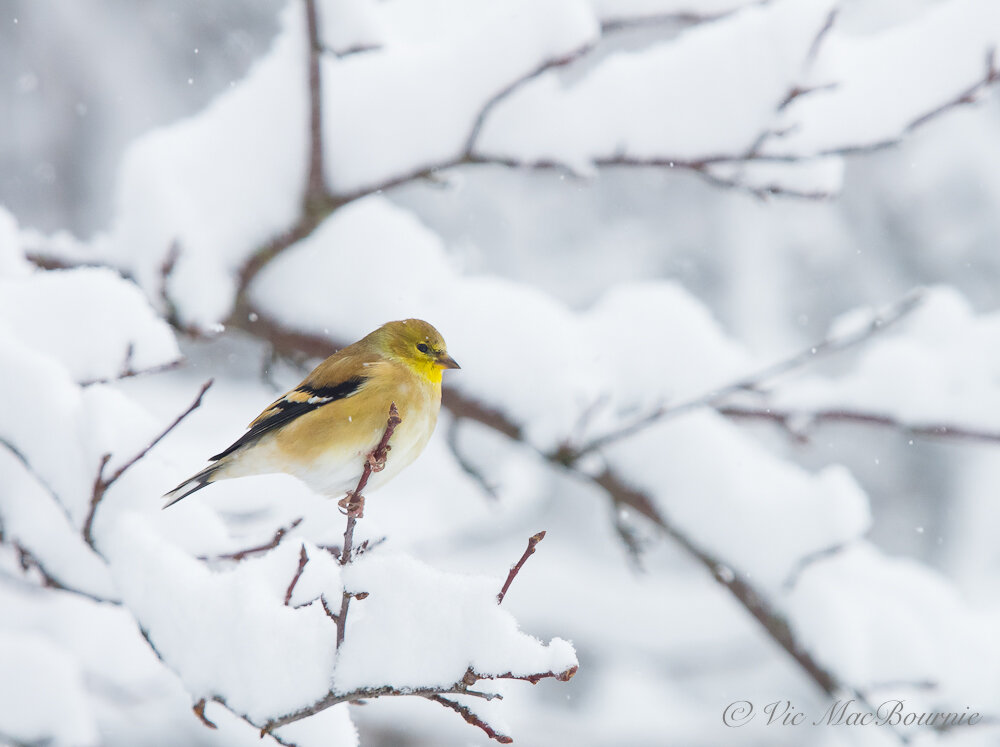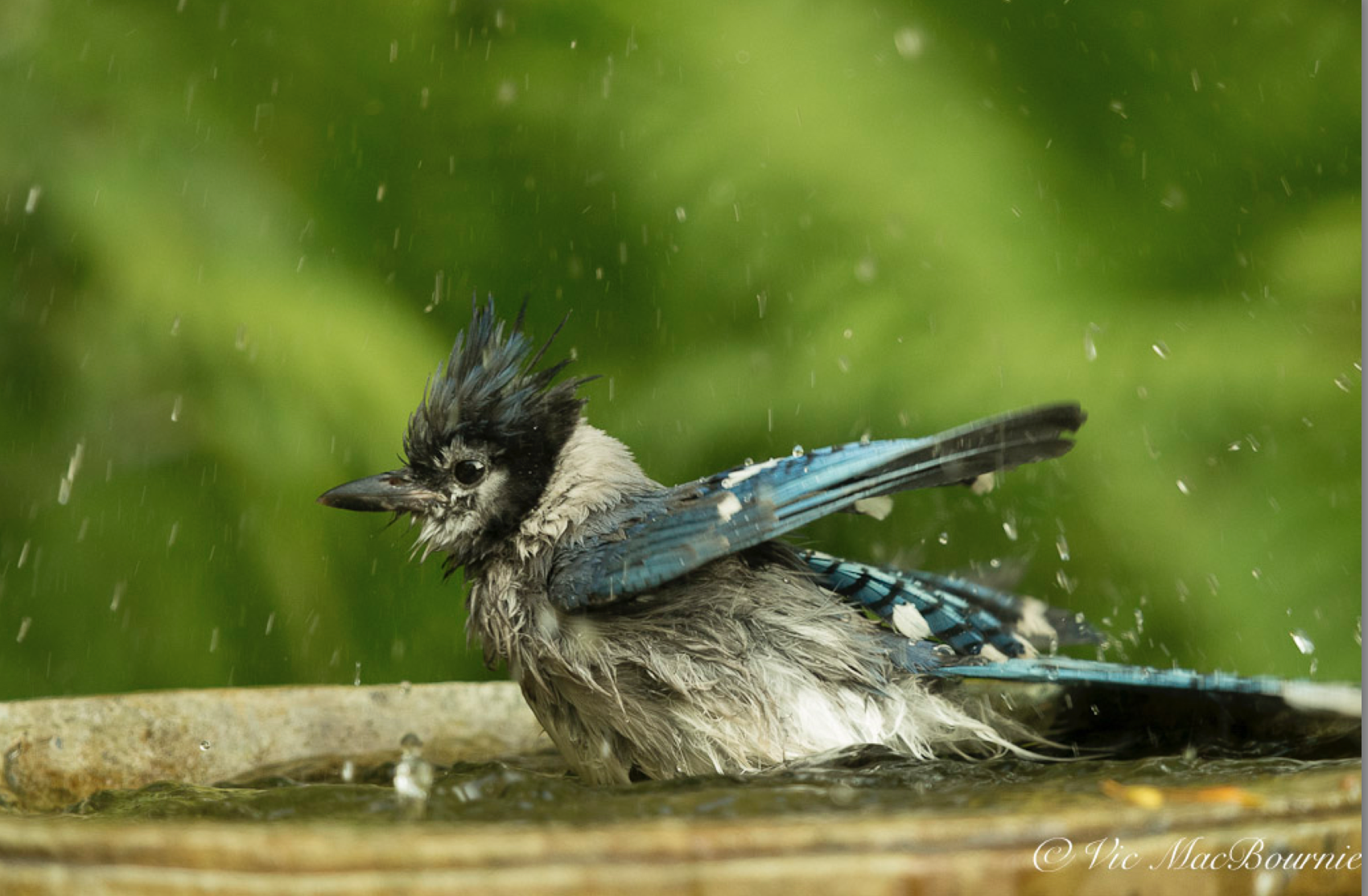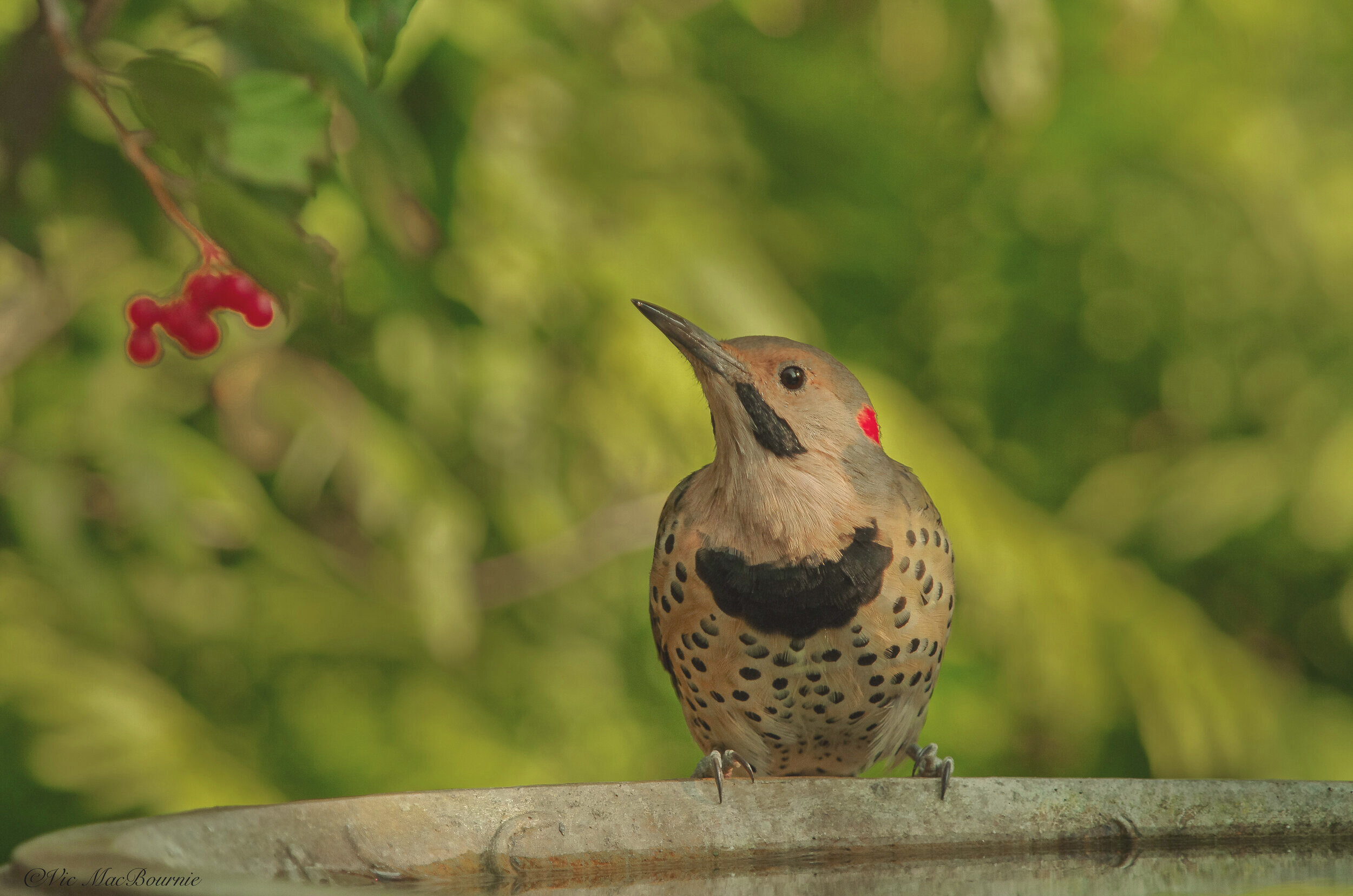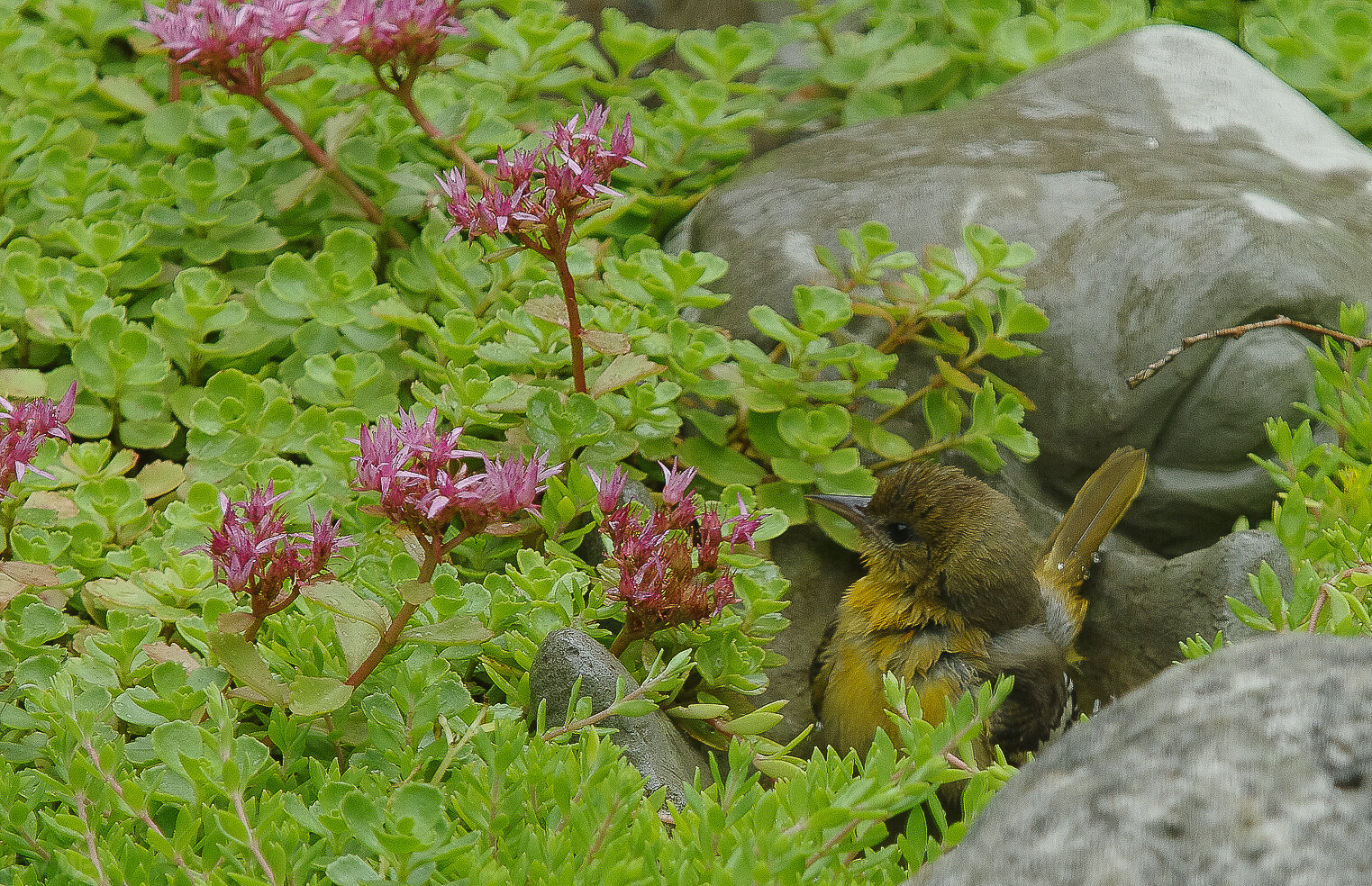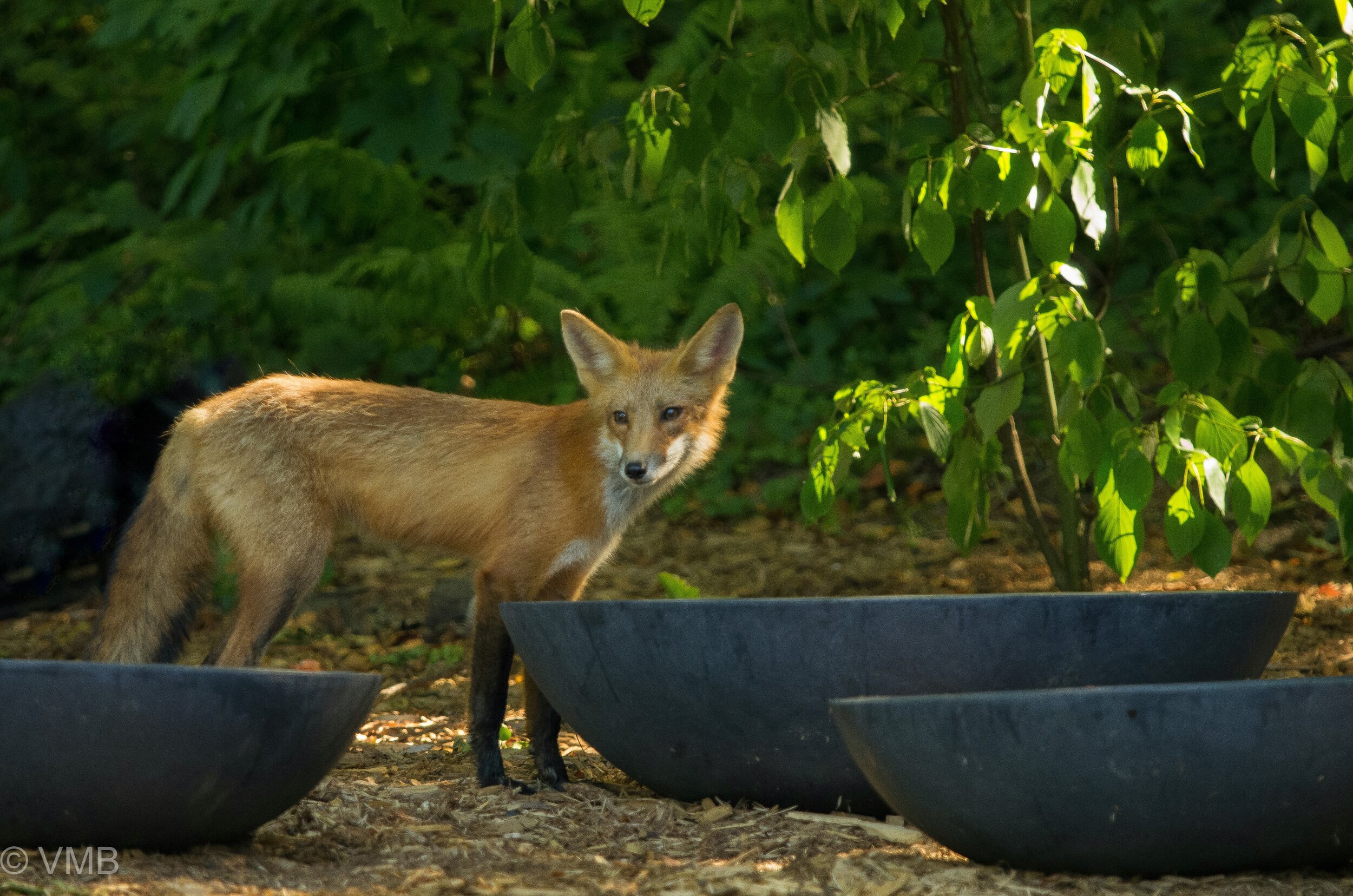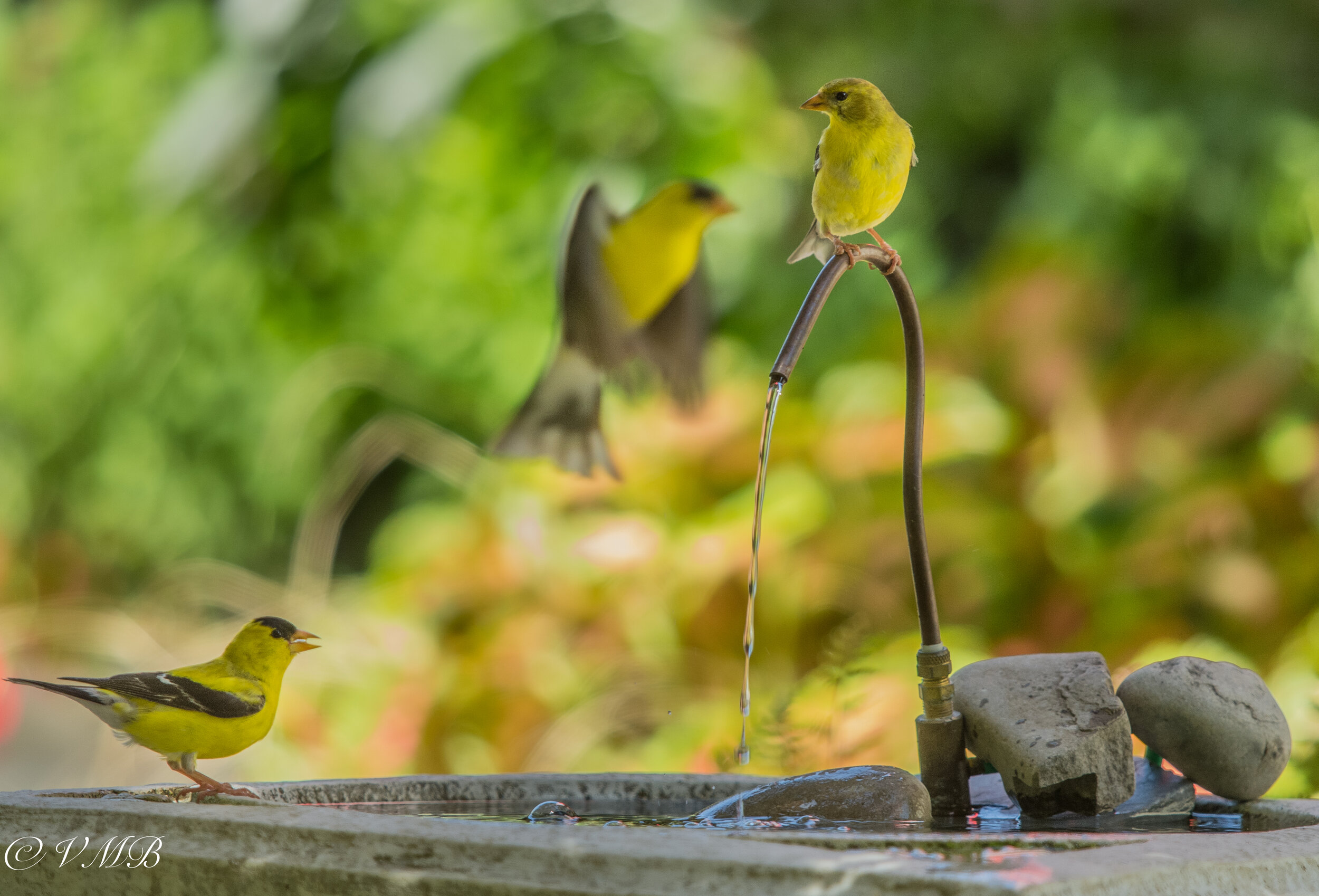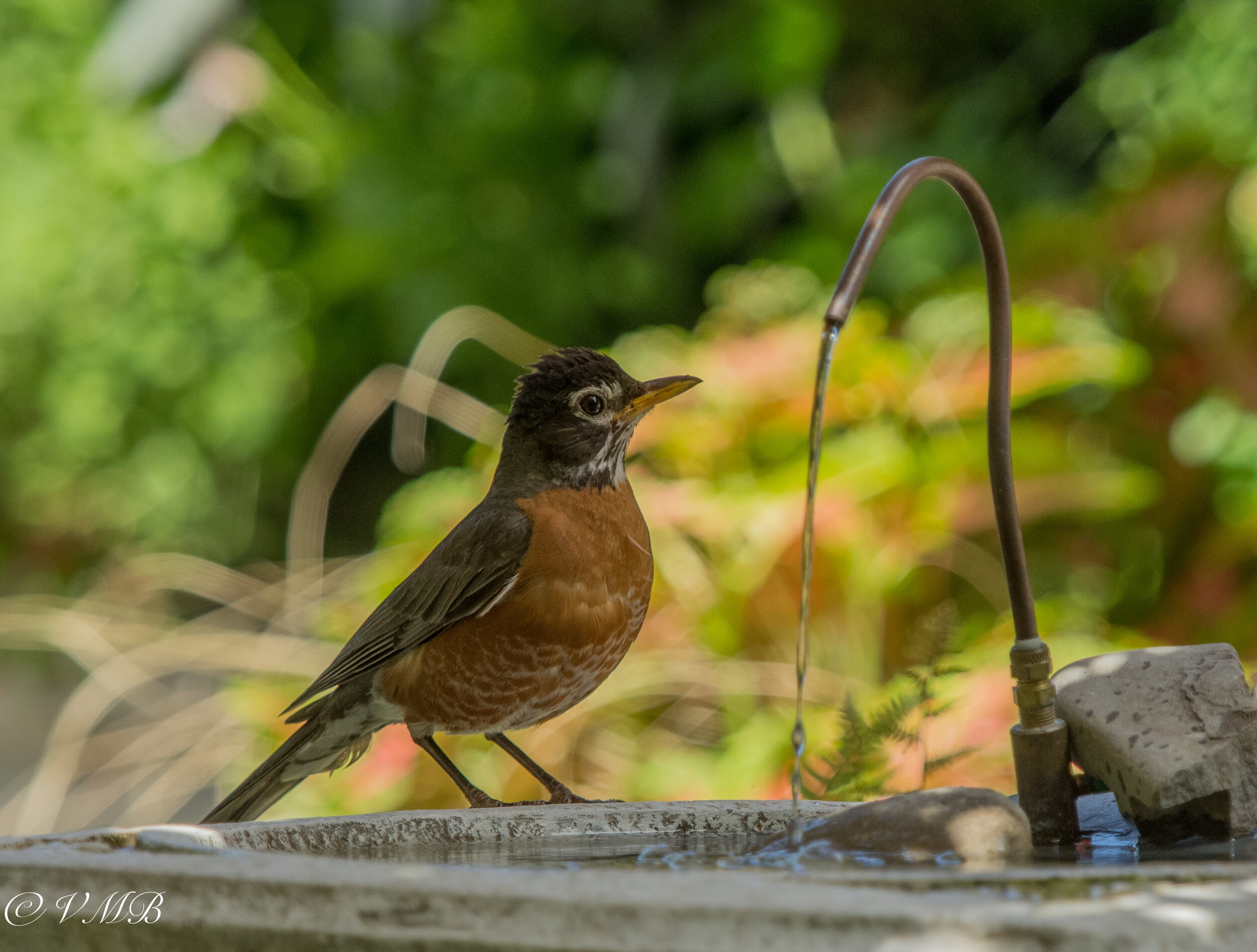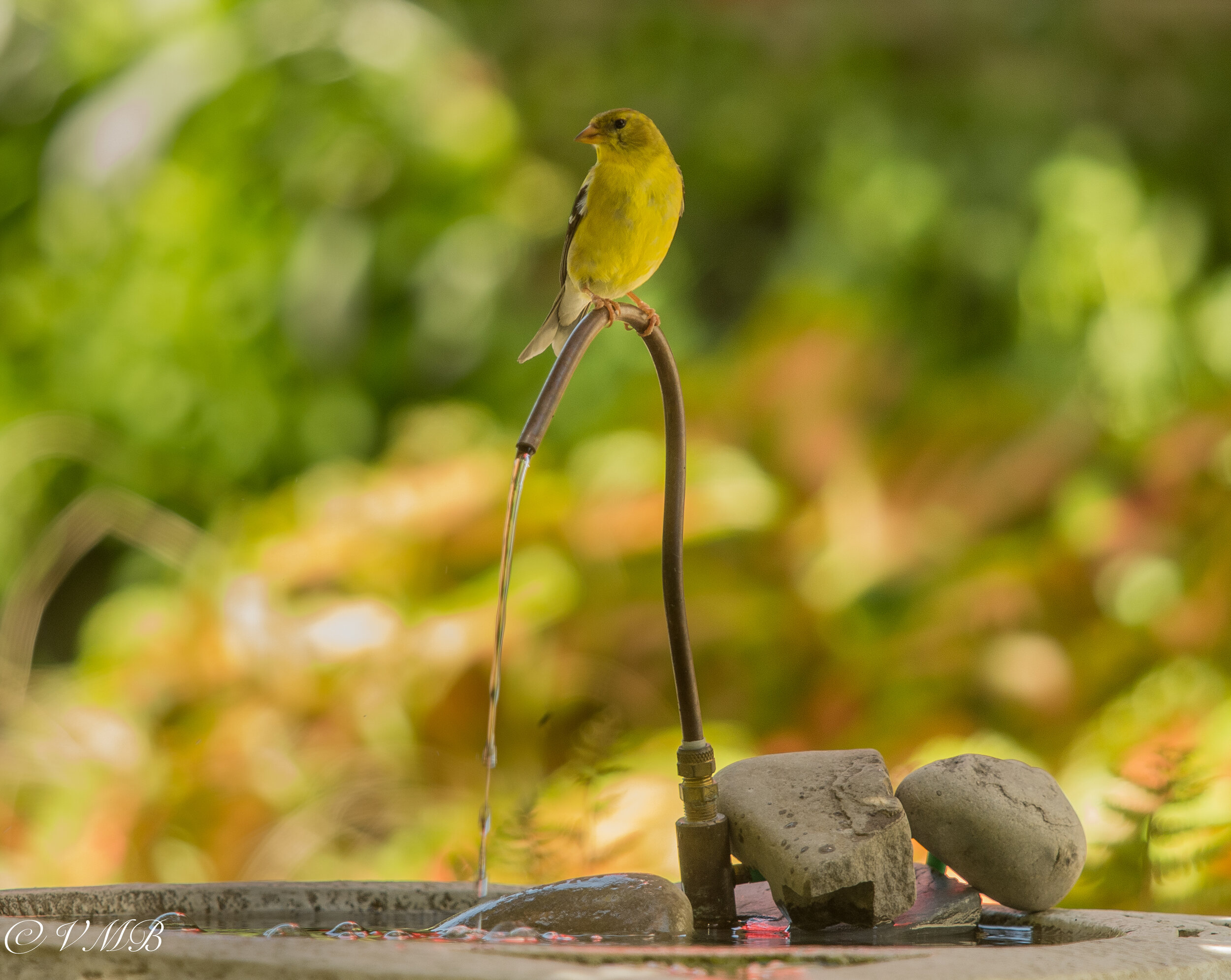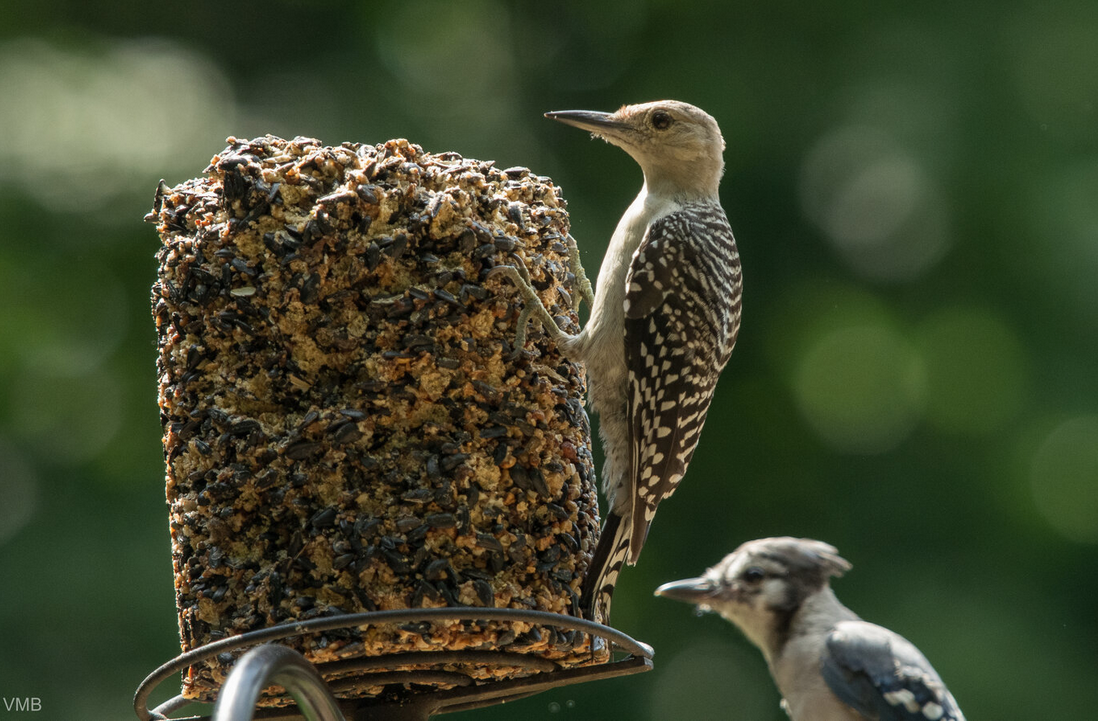Five of the best backyard birding books
Winter is approaching an time for woodland gardeners to change focus from their gardens to backyard birds and wildlife. Here are five outstanding books that will help birders get the most out of their backyard feeders by attracting the greatest number and variety of birds to their backyard.
Tips to attract more birds to your backyard
Winters can be hard on us, but have you ever wondered what our feathered friends go through when the temperatures drop and snow covers the ground and their normal sources of food?
For birds and other wildlife, winter is a difficult time and finding a reliable source of food often becomes a matter of life and death.
As more and more native plants disappear, bird feeders become more and more important to backyard birds.
In our garden, many of the traditional backyard birds are already busy stockpiling sunflower seeds in every nook and cranny they can find, whether its tree bark or tucked between crevices in garden benches and other secret backyard hideouts known only to them.
How successful we are in attracting birds and wildlife depends on many factors. Thankfully, many of these factors are within our control.
Providing habitat for our feathered friends, for example, is an ongoing project created over time. There are steps, however, we can take immediately to provide a safe haven for our woodland wildlife. A brush pile (click here for earlier post) is one such addition that will help bring in a greater variety of birds including owls and other predators (click for earlier post on attracting owls) that will begin to see it as a source of food in the form of mice and other small critters that call it home.
If you are looking to purchase one of these books, or any Gardening or birding book for that matter, be sure to check out the incredible selection and prices at alibris books.
Native plants that include berries and fruit will attract fruit-eating birds and mammals that may not be attracted to our bird feeders. Please take a moment to read my complete story on using native plants in our garden
Winter is also the ideal time to learn more about helping out the wildlife that either call our gardens home or visit it on their neighbourhood rounds. The following are five of the best books available for backyard bird watchers and those who want to attract more of them to our yards. They are conveniently linked to Amazon, but many can be found or ordered through your local bookseller.
Alibris is an umbrella group of independent booksellers from the U.S. and the U.K. that provide exceptional deals on used books and music. Be sure to Also check Alibris for great prices on new and used books.
1) All About Backyard Birds: Eastern and Central regions.
Available in paperback new and used.
Most birders are familiar with the Cornell Lab of Ornithology’s excellent birding website and handy app on their smartphone. In fact, I doubt there are many serious birders who are not using the handy birding app to help us identify unusual birds in our garden either by sight and unusual markings, or through their many songs and calls. This book is based on that website, which has had more that 14 million unique users to date.
It’s perfect for a new birder, young and old.
The highly regarded book, published in 2017, has an impressive has a very positive rating with 60 on-line ratings.
The publisher notes that the book: “delivers best-in-class content and proven user-friendly formats. Each regional version – eastern/central North America and western North America – provides 120 of the most popular species and is filled with beautiful illustrations by Pedro Fernandes. With charts, maps, and other bird identification tools, All About Backyard Birds offers beginner birders the ideal way to start birding.”
The book also includes a tutorial for the MERLIN app (available for free on line) already being used by more than 1 million birders.
A portion of the net proceeds for the sale of the book goes directly to the Cornell Lab to support projects, including children’s educational and community programs.
2) National Geographic Backyard Guide to the Birds of North America, 2nd Edition.
Available in paperback both new and used for very reasonable prices.
This is another top notch general source for backyard birders, and it’s hard to go wrong with any product from National Geographic. For travellers, at least in North America, this guide offers an excellent source of information.
The publisher writes: “This comprehensive and beloved guide reveals the most ubiquitous and remarkable species of North American birds, clearly organized by family and paired with identification tips, behaviour, vocal descriptions, and more. The new edition features a "Backyard Basics" section from the world's most prolific birdwatcher, Noah Strycker, with tips on attracting and feeding your favourite birds and creating bird-friendly landscapes. Also included are updated descriptions of 150 common North American species, paired with comprehensive range maps, as well as lush indentification artwork and bite-sized facts. With new contributions from Strycker and a modern redesign, the second edition of this perennial favourite will appeal to new and experienced bird enthusiasts alike.
3) The Backyard Bird Feeder’s Bible: The A-to-Z Guide To Feeders, Seed Mixes, Projects And Treats.
Available in both hardcover and paperback both new and used formats.
Rodale has always been a strong publisher when it comes to gardening books. I have a number of them that I go back to on a regular basis. In fact, Landscaping with Nature, Using Nature’s Designs to Plan Your Yard by Jeff Fox published by Rodale Press, was my go-to book for planning and designing much of my woodland gardening book going back at least ten years ago. The book explains the fine details of creating a natural garden right down to using classical music to place large boulders in your garden. It’s proven to be a very valuable resource.
The author of the Backyard Bird Feeder’s Bible, Sally Roth, will help guide backyard birders to focus on which foods attract which birds, hints on choosing and maintaining feeders and the best native fruit-bearing trees, flowers and shrubs to plant to attract birds.
The publisher writes: Pull up a chair next to the window looking out on your bird feeder and join author Sally Roth in an informative, inspirational, and often light-hearted look at the foods, feeders, and plants that invite birds to visit your feeding station.”
The author shares a lifetime’s worth of bird-feeding experience including how to identify birds at your feeder, and what foods are best for certain birds. She also includes tips on improving the attraction of your garden to birds.
4) National Wildlife Federation: Attracting Birds, Butterflies, and Other Backyard Wildlife, Expanded Second Edition.
Another outstanding book by the highly regarded National Wildlife Federation. It’s available in both Kindle and paperback forms, new and used for a very reasonable price.
If you are not familiar with the National Wildlife Federation, it is the largest U.S. nonprofit conservation organization, with 6 million members and 51 state affiliated organizations.
This book takes backyard birding to another level by urging readers to – not unlike this blog – create a backyard that is more nature-friendly by providing habitats for local wildlife, not just birds. The book includes 17 step-by-step projects that brings the entire family back to nature with easy projects. The book explores wildlife-friendly practices and how to attract backyard pollinators.
The reward from following the many ideas in the book is not only a more wildlife-friendly yard, is a blueprint for getting your garden certified by the National Wildlife Federation’s Garden for Wildlife program by following the certification application checklist that is included in the book. A worthwhile investment in its own right and one that our garden qualified for a number of years ago.
The publisher writes: Your backyard can come alive by creating an environment with plants and spaces that attract nature’s most interesting and friendly creatures! Colourful butterflies, uplifting songbirds, and lively toads can enhance your personal garden space, giving pleasure to nature lovers of all ages.”
“Author David Mizejewski, a naturalist with the National Wildlife Federation, presents simple plans for reintroducing native plants that birds, butterflies, and a whole host of critters can't resist.
5) The Humane Gardener: Nurturing a Backyard Habitat for Wildlife (How to Create a Sustainable and Ethical Garden the Promotes Native Wildlfie , Plants, and Biodiversity.
Nancy Lawson’s the Humane Gardener is a must for any gardener who cares about attracting wildlife to their backyard, whether its birds, mammals or creepy crawlies. Her new book Wildscape is another book serious natural gardeners will want to add to this list.
Click on the link for my complete review of her book The Humane Gardener. Click on this link for my review of her book Wildscape.
Available in Kindle format and hardcover both new and used at a very reasonable price.
The book follows much the same philosophy as this woodland garden blog: one that focuses on a “practical guide for the gardener who hopes to create a backyard in harmony with nature.”
The author, Nancy Lawson, examines why and how to welcome wildlife to your backyard through profiles of home gardeners as well as interviews with scientists and horticulturalists.
The book includes information on planting for wildlife by choosing native plants, providing proper habitats for animals as well as birds, bees and butterflies and encouraging natural processes and evolution in your garden.
Finally she explores the “humane gardener,” who she describes as someone who attracts wildlife and peacefully resolve conflicts with all the creatures that may inhabit your garden. The humane gardener, she concludes, “is someone who sees the garden as a meeting place for all creature, not a territory to be defended.”
Isn’t that the way we all want to garden?
Author Profile: Vic MacBournie is a former journalist and author/owner of Ferns & Feathers. He writes about his woodland wildlife garden that he has created over the past 25 years and shares his photography with readers.
Bark butter and DIY bird feeders
The combination of a DIY feeder and WBU’s Bark Butter is an irresistible draw for more than 150 species of birds. If attracting woodpeckers, nuthatches and chickadees along with warblers sounds good, check out this simple and easy to make feeder and food combination.
Natural feeder is irresistible to 152 species of birds
Combining Bark Butter with a DIY bird feeder has become my favourite combination for attracting woodpeckers, nuthatches and chickadees to my wildlife, woodland garden.
It has also quickly become my favourite feeder combo to photograph birds in a natural setting.
So if you are like me and love either photographing backyard birds, or simply watching woodpeckers, nuthatches and other suet-loving garden visitors as they peck away gathering food for the winter, then you will love the simplicity of creating this DIY branch feeder. The feeders are so easy to make and appreciated by out feathered friends that I’ve already made two and plan on making many more in the near future.
But before digging in on how to make the DIY feeder let’s talk a little about Wild Birds Unlimited Bark Butter.
There are other spreadable-suet products available that might suit your needs. I just can’t speak to them. I do plan to order some of these products from Amazon and will report back.
A woodpecker removes a piece of Bark Butter from the DIY branch feeder.
What’s Bark Butter?
Bark Butter is a spreadable suet-peanut butter and corn blend that can be easily spread on a rough surface like tree bark or stuffed into holes or small crevices that are easily accessible to many birds. It is especially accessible to those birds with long beaks that can reach into cracks and areas where squirrels may have difficulty reaching. It is sold, in many different forms, through Wild Birds Unlimited stores and on line throughout Canada and the United States. The formula for Jim’s Birdacious Bark Butter is said to be created by Jim Carpenter, founder of Wild Birds Unlimited. It is advertised as a food source that attracts a greater variety of birds than any other food source including regular suet.
This Flicker is working one of the many Bark Butter pockets in the DIY branch feeder.
I can’t verify the claims that it attracts more than 152 species of birds, but I can verify that this stuff is a joy to use. Its peanut butter base makes handling it enjoyable. In fact, I mostly just scoop it out of its plastic container using my hands and stuff it into the holes I’ve drilled into the DIY feeder tree branch. Any access bark butter that gets on my hand is simply rubbed into the crevices of the branch’s bark.
Getting back to those 152 different species that Bark Butter is said to attract. I have no doubts that the claims are true that Bark Butter attracts everything from woodpeckers like Flickers, Downies, Hairy and red-breasted woodpeckers, to Brown Creepers, Chickadees, Jays and even warblers. As many know, attracting warblers to our gardens is not always easy. Anything that brings warblers into the yard is a good thing and, since Warblers are big insect eaters, the bark bits with insects would be a good choice to attract them.
Bark Butter is not inexpensive so care should be taken to use it wisely and do everything possible to keep squirrels and other mammals from feasting on it.
Although it is recommended to be spread on tree bark, if squirrels discover it before the birds, there’s a good chance they’ll devour most of it before the birds get to it.
The DIY feeder helps solve this problem. Because it can be hung from a feeding station complete with squirrel baffles and placed is an area of your garden that makes access difficult for raccoons, squirrels and other garden critters, it’s easy to maximize the benefits of the butter.
As an experiment, I have created two of these feeders. One is hanging off the feeding station and therefore protected from squirrels. The other feeder is part of a large tree branch that has been dug into the ground and allows easy access to red and grey squirrels among other backyard wildlife critters who discover it.
A Nuthatch feasts on Bark Butter at the lichen-covered DIY branch feeder.
As a result of the experiment, I can attest to squirrels’ love of Bark Butter and the importance of making access difficult for them. Once loaded up, the Bark Butter feeder on the feeding station remains available to the birds for several days, while the branch feeder is more or less devoured in a day or two. I suppose using the hot pepper mix is appropriate in this circumstance to keep squirrels away, but after my fair share of hot wings, I’m not a fan of teaching the squirrels a hard-earned lesson.
In the end, I like both feeders. If saving money is important to you, however, it’s probably wise to make it difficult for squirrels to get access to your DIY feeders.
The bark butter is available in plastic tubs in both regular and a hot pepper blend that helps detract squirrels from feasting on the rather expensive feed. It’s also available in a Bugs and Bits blend, which incorporates small pellets of bark butter together with insect parts including meal worms. The same pellet-shaped Bark Butter Bits are available without the insects and with hot pepper. There is also Bark Butter quickbites and a large no-melt suet cyclinder. Both are available in regular and hot pepper.
Be aware that some Wild Birds Unlimited locations choose not to sell the hot pepper Bark Butter.
For more on Building your Garden on a Budget go here.
While I get great enjoyment from my bird feeding stations, providing natural food sources to our feathered friends is always the goal we should aspire to in our gardens. I have written a comprehensive post on feeding birds naturally. You can read about it here.
Simple, easy-to-create DIY feeders
There are many different ways to use Bark Butter. One of the simplest ways is to gather pine cones from the garden and smother them with the bark butter. These can be hung from tree branches throughout the garden especially during or just before a snowfall.
But my favourite method is to use a one- or two-foot branch cut from or left over from a tree pruning, either from your own tree or a neighbours’. My feeders are a little thicker than a man’s wrist, but larger, heavier branches can be used for larger woodpeckers like the Pileated woodpecker.
These feeders are so simple to make that the process is almost not worth describing. But here is a simple description of the process.
• Drill a hole through the branch maybe an inch or two down from an end to insert string or preferably wire, which will be used to hang the feeder.
• Then, using a larger drill bit, start drilling several pockets or holes in the branch at regular intervals.
• If there is a side branch, leave some of it to act as a small perch for the birds. Then drill a hole above the perch to act as a convenient location for birds to get easy access to the Bark Butter.
• I use a combination of drilled pockets that go half way into the branch, full holes drilled right through the branch to provide birds with different length beaks access to the butter.
• Once the wire is attached and the Bark Butter applied, you can hang the feeder. Leave room around the feeder to give visitors access from all sides.
• Refilling the tree branch with suet is just a matter of taking a clump of the Bark Butter and stuffing it into the holes. I do it with my hands but you could use an old spoon. Wild Birds Unlimited says to use a fork for the final application because the rungs leave a criss-cross pattern in the butter that birds can easily pick off and eat.
Create a free-standing feeder for all garden visitors
• Our other Bark Butter feeder is nothing but a larger 8- to 9-foot branch partially buried into the ground a couple of feet.
• Once stabilized in the ground, drill several holes and pockets in the branch at various heights to provide birds with several feeding areas up and down the branch.
• Smaller holes can be drilled into the branch to insert perches for birds or long screws to hang smaller feeders from. This is an ideal spot to add Bark Butter-infused pine cones.
• I like to fill this bird feeder an hour or two before going out to photograph the birds to give me another potential photo location.
Branch feeders are ideal photographic stages
This larger branch has become a favourite location for birds and squirrels who enjoy taking up a position on top to scan the garden. It has only been up for about eight months and I’m sill waiting for a large hawk or owl to discover it and use it as a hunting perch.
But I’m confident that time will come and I hope to be there in my Tragopan V6 photo blind ready to capture the image.
In the meantime, I’ll enjoy the large variety of backyard birds providing me with endless photographic opportunities on my two natural feeders.
The lure of the DIY branch feeder and Bark Butter is irresistible to so many birds. This makes it ideal for photographers to capture natural images (much like the ones featured in this article) of the many varieties that visit. The DIY feeder combined with a photographic blind like the Tragopan V6 one-person blind, makes it easy to get up close to some of your favourite species. The feeders and the blind are also portable enough to move them around the garden to obtain the background of your choosing.
If photographing birds is one of your primary goals behind creating the branch feeders, be careful to drill your holes strategically to hide as many as possible from the camera lens. By keeping the suet pockets on one side and shooting from an angle that keeps the suet more or less hidden, the resulting photos can look very natural.
I like to look for branches from older trees that already have lichen and moss growing on them. A chainsaw makes creating several lengths of feeders easy and quick work.
Gardening on a budget links
Ten money-saving tips for the weekend gardener
DIY Bark Butter feeder for Woodpeckers
DIY reflection pond for photography
Click & Grow is ideal for Native Plants from seed
Garden photography: Tips to photographing hummingbirds in flight
Backyard bird photography involves planning, patience and the right equipment. Months of planning, hours of waiting and about five seconds of shooting resulted in this photograph of the hummingbird at a native cardinal flower.
Planning, patience: Key to capturing garden bird photographs
Garden photography isn’t always easy. In fact, I figure the photo took about six hours of patience and five seconds of shooting.
The result, pretty close to what I hoped for photographing with natural light in the shade of a magnolia tree. An electronic flash would certainly have punched it up both in colour and sharpness, but I decided to go with natural light.
The flash photo can wait for now.
Was luck involved? There is always a certain amount of luck in any good image, but to me luck would have meant getting the photograph in the first half hour, not the sixth.
Photographers looking to do more backyard bird photography might find it helpful to delve a little deeper into the creation of this image.
If I could have only one lens for wildlife and birds in the garden, it would be my F* 300mm F4.5. Check out my full story on the lens by clicking the link.
Much like most bird photography, good planning, lots of patience, and the right equipment went a long way in capturing the image.
Hummingbird feeds from a cardinal flower in the garden.
Planning: The planning started when I ordered the native plant from Onplants.ca back in the spring. I knew hummingbirds loved Cardinal flowers so I ordered three and planted them in an area where they would prosper. Then, I planted it where I would have easy access to them for photography. Beside the patio and a couple of feet from where I normally sit is the ideal location. And, so, that’s where the plants found a home. Nearby, there are three hummingbird feeders that encourage the birds to the general vicinity to where the plant is located.
Patience: Six hours speaks to the patience it took to get the shot. That length of time can be extremely long if you are out in the field, but sitting in a comfortable chair in the backyard makes the wait much easier. It’s one of the big benefits of practising backyard bird photography. Have a coffee, a beer or maybe a glass of wine and take your best shots. Couldn’t be easier.
In most cases a photography blind is not needed when shooting hummingbirds providing you take the time to acclimatize the birds to your presence.
(If you are interested in exploring garden photography at a higher level, be sure to check out my comprehensive post on the Best camera and lens for Garden Photography.)
Looking to upgrade your camera or lenses? Check out the excellent used cameras and lenses at KEH Camera Exchange.
Even if you’re not taking pictures, sitting out in the same chair and moving slowly will eventually cause the birds to recognize you as nonthreatening and allow them to go about their day as if you are not really even there.
This will not work with all birds, but many, especially Hummingbirds will eventually simply ignore you if you are always around their feeders.
Equipment: Bird photography has always been a specialty field involving high-powered cameras, motordrives and long, fast, expensive lenses. A visit to Point Pelee during spring migration, or any other of the birding hot spots around the globe, will certainly convince you that admission into serious bird photography requires more than an iphone or a point-and-shoot camera.
That’s not to say that with very careful planning you can’t get some good shots with these cameras. It’s just that it would be hard to do it consistently and the effort put forward might not be worth the results.
The small size of the hummingbird makes it even more difficult to get good results with these cameras.
So, with that in mind, I took the hummingbird challenge armed with a 35mm SLR camera with built-in motordrive and a 300mm F4.5 close-focusing telephoto lens (with a focal lens of around 450mm on the cropped sensor).
If I could have only one lens for wildlife and birds in the garden, it would be my F* 300mm F4.5. Check out my full story on the lens by clicking the link.
But this was not really the secret behind getting the photograph. They are merely the tools that helped make it possible.
The secret was a tripod, an electronic shutter release, and a camera set on backfocus.
With the camera locked into place on the tripod, and the electronic release ready to trip the shutter without moving the camera, the plan was almost complete.
If you are considering a new camera or lens to capture your best garden photography, travel photography or maybe just your kids and grandchildren, consider checking out the exceptional used camera equipment at KEH Camera Exchange. It’s a U.S. based camera and lens reseller. click on this link to check out their daily offerings.
However, one big problem remained. Normally, when you press the shutter halfway down, the camera refocuses, often going into search mode to find something to focus on. Trying to focus blindly with the hummingbird moving about makes it close to impossible.
That’s where back focus came into play.
What’s back focus you may ask?
On the back of most higher-quality 35mm SLRs is a button that enables the photographer to focus separately from the shutter control button. By using the back focus button, I was able to prefocus on the flowers and then release the shutter without it refocusing when the hummingbird reached the area where I expected it would be in-focus.
Focusing on the flower and then putting the camera into manual focus mode would also have worked.
In the end, the combination of planning, patience and equipment came together to create a pleasing shot. Months in the planning, hours of waiting for the plan to come together and a few seconds of actual shooting made it all happen.
A lucky shot if I ever saw one.
A female ruby-throated hummingbird feeds from a cardinal flower on a sunny afternoon.
Later in the season, I set up a similar situation where the Cardinal flower was primarily in the sun.
The higher shutter speed that the additional light provided helped to get the frenetic little bird in focus and brightened the colours in its feathers. I’m not sure I like the photos any more than the earlier images taken in a shadier part of the garden, but taking it was certainly a simpler process.
Again, patience was the key. The process was similar. Camera on a tripod focused on the flower (again using the back focus button) and a remote release attached to the camera. Every time the hummingbird came to feed, I took several photographs hoping that enough of them would be in focus and sharp.
As I said earlier, photographing the bird in a sunny location brought out the colours, provided a highlight in the bird’s eye and allowed me to shoot at a higher f-stop which helped to capture more of the bird in focus.
This page contains affiliate links. If you purchase a product through one of them, I will receive a commission (at no additional cost to you) I try to only endorse products I have either used, have complete confidence in, or have experience with the manufacturer. Thank you for your support. This blog would not be possible without your continued support.
A Winter Woodland wish for the holidays
The beauty of the woodlands and our backyard birds is illustrated through photographic images, poetry and quotes. Together, they remind us of why we love our backyard woodland gardens that bring birds to our yards and joy to our family's hearts.
“Our gardens took us through some very difficult times this past few years, but let’s hope the end is in sight. Let’s take the opportunity to celebrate our gardens. I have put together a few favourite poems, quotes, thoughts and images to help us get through these final months before summer returns and our gardens and the world we live in spring back to life.”
A winter rebirth is rolling in
For many of us, our gardens represent an important part of who we are.
They give us the freedom to be ourselves; to indulge our creative minds; to touch the earth; to quietly experience the natural world as it comes to life around us.
In spring, our expectations soar and we visualize, always hopeful, how magnificent our gardens will become when the sun finally warms the frozen ground.
We wait, in great anticipation, for those first signs of spring. The first Trillium, the first Monarch… our first hummingbird. Each year the first sighting is as special as past years.
Our garden, our pride
This is our garden. It doesn’t matter if it’s a sprawling landscape stretching far off into the hills, or a small city lot that awakens each morning to the hustle and bustle of street sounds. This is where we call home. This is where we have chosen to set roots, to create our retreat, our safe place.
It’s where we enjoy our first coffee. Smell the fresh scent of the morning air and take in the sound of birds filling our trees with their sweet songs.
“Why do you try to understand art? Do you try to understand the song of the bird?”
In winter we wait.
From our windows, we look out at our feathered friends and welcome them into our gardens. We feed them, provide them with water and create protected areas where they can escape the cold winds that chill us to the bone.
Winter is their time in the garden, while we plan for the future … for a better day.
And that better day is coming.
The day we can open our gardens to our friends and family.
These past few years have been difficult.
Our gardens have given us much to be thankful for. A place to escape, a refuge to explore our creative desires and dreams.
As this year draws to a close, it’s important to remember how lucky we are to be able to share this space with Mother Nature.
“Birds sing after a storm; why shouldn’t people feel as free to delight in whatever remains to them?”
While we recovered from a dangerous virus that took the life of so many friends, our gardens rested too from the normal hustle and bustle. Animals around the world celebrated the quiet solitude that spread over the land. They began to take back much of what was once only theirs. In cities around the world, animals mostly confined to woodlands roamed more freely through the streets and into our gardens.
As the world slowed down, so did the sounds that disturbed the peace in our gardens.
Maybe, this was the time many of us learned to love our gardens.
Now we need to once again learn to love the crunch of leaves under foot. Find the pleasure in the spider spinning its web.
Let nature take root. Put away the chemicals. Let the grass grow between our toes to become a meadow. Listen to the crickets. Dance with the fireflies.
Listen to nature. Listen to what our gardens are telling us. It has something important to say.
“As long as I live, I’ll hear waterfalls and birds and winds sing. I’ll interpret the rocks, learn the language of flood, storm, and the avalanche. I’ll acquaint myself with the glaciers and wild gardens, and get as near the heart of the world as I can.”
Stopping by Woods on
a Snowy Evening
Whose woods these are I think I know.
His house is in the village though;
He will not see me stopping here
To watch his woods fill up with snow.
My little horse must think it queer
To stop without a farmhouse near
Between the woods and frozen lake
The darkest evening of the year.
He gives his harness bells a shake
To ask if there is some mistake
The only other sound’s the sweep
Of easy wind and downy flake.
The woods are lovely, dark and deep,
But I have promises to keep,
And miles to go before I sleep,
And miles to go before I sleep.
-Robert Frost
The Song of
the Chickadee
Be as a bird perched on a frail branch that she feels bending beneath her,
still, she sings away all the same, knowing she has wings.
Victor Hugo
“Can you imagine a world without trees
How long do you think you’d survive
Put yourself to the test, try it with ease
Hold your breath for the rest of your life”
“That little bird has chosen his shelter. Above it are the stars and the deep heaven of worlds.
Yet he is rocking himself to sleep without caring for tomorrow’s lodging, calmly clinging to his little twig, and leaving God to think for him.”
-Martin Luther
“I love the sound of the wind in the trees and the song of the birds and the shuffle in the leaves of my many woodland friends.”
“I wonder if the snow loves the trees and fields that it kisses them so gently?
And then it covers them up snug, you know, with a white quilt; and perhaps it says, ‘Go to sleep, darlings, till the summer comes again.’”
-Lewis Carroll
“What good is the warmth of summer, without the cold of winter to give it sweetness.”
Feed the birds in winter;
in return, they will feed your soul with the look of gratitude!
- Mehmet Murat ildan
I soared above the song birds
And never heard them sing
I lived my life in winter
And then you brought the spring
- Randall Wallace
“On harsh, frigid January days, when the winds are relentless and the snow piles up around us, I often think of our small feathered friends back on the Third Line. I wonder if the old feeder is still standing in the orchard and if anyone thinks to put out a few crumbs and some bacon drippings for our beautiful, hungry, winter birds. In the stark, white landscape they provided a welcome splash of colour and their songs gave us hope through the long, silent winter.”
“I prefer winter and fall, when you feel the bone structure of the landscape – the loneliness of it, the dead feeling of winter. Something waits beneath it, the whole story doesn’t show.”
- Andrew Wyeth
“Let me bring you songs from the wood
To make you feel much better than you could know
Dust you down from tip to toe
Show you how the garden grows”
When winter winds are piercing chill, And through the hawthorn blows the gale,
With solemn feet I tread the hill,
That over brows the lonely vale.
O’er the bare upland, and away
Through the long reach of desert woods,
The embracing sunbeams chastely play,
And gladden these deep solitudes.
Where, twisted round the barren oak,
The summer vine in beauty clung,
And summer winds the stillness broke,
The crystal icicle is hung.
Where, from their frozen urns, mute springs
Pour out the river’s gradual tide,
Shrilly the skater’s iron rings,
And voices fill the woodland side.
Alas! how changed from the fair scene,
When birds sang out their mellow lay,
And winders were soft, and woods were green,
And the song ceased not with the day!
But sill wild music is abroad,
Pale, desert woods! within your crowd;
and gathering winds, in hoarse accord,
Amid the vocal reeds pipe loud.
Chill airs and wintry winds! my ear
Has grown familiar with your song;
I hear it in the opening year,
I listen, and it cheers me long.
-Henry Wadsworth Longfellow
“Have you seen Jack-in-the-Green?
With his long tail hanging down.
He sits quietly under every tree
In the folds of his velvet gown.
He drinks from the empty acorn cup.
The dew that dawn sweetly bestows.
And taps his cane upon the ground -
Signals the snow drops, it’s time to grow”
There is nothing in the world more beautiful than the forest clothed to its very hollows in snow. It is the still ecstasy of nature, wherein every spray, every blade of grass, every spire of reed, every intricacy of twig, is clad with radiance.
-William Sharp
Seven Viburnums: Top shrubs to attract birds to your garden
Building up the number of viburnums in your garden design is a great way to not only beautify your backyard but create a garden that is attractive to a wide variety of birds. Viburnums provide an abundance of flowers in spring, attract pollinators, insects and caterpillars throughout the summer, outstanding leaf colour in fall and an abundance of berries in fall lasting well into the winter.
High bush Cranberry is both beautiful and attracts birds
There is no question that shrubs in the Viburnum family are ideal choices for bird and wildlife lovers. But it’s important to note that they’re not just for the birds.
Gardeners will appreciate our native Viburnums as much in the spring garden with their impressive display of white flowers that attract an array of pollinators, as they will in the fall when their berries are in full bloom.
The one thing you should remember, however, is that you can’t have a bird garden without Nannyberry, Witherod, Hobblebush or High bush Cranberry.
In fact, woodland gardeners looking to attract an array of colourful birds to their backyards should consider the Viburnums as the stalwarts of their shrub borders.
While I get great enjoyment from my bird feeding stations, providing natural food sources to our feathered friends is always the goal we should aspire to in our gardens. I have written a comprehensive post on feeding birds naturally. You can read about it here.
The large family of shrubs provides birds with most of what they need, from nesting and shelter areas, to insects and a plethora of berries.
A Hermit Thrush eyes the fruits of the High bush Cranberry in the wooodland garden.
In zone 5, gardeners can expect fruit to be on display from as early as June through to January and beyond.
Your local high-end garden centre should carry a good selection of viburnums (see link at bottom of post) to choose from, just make sure that they are not hybrids that no longer provide resources for our backyard wildlife.
During the spring and summer, Viburnums are host to a selection of leopidoptera (butterflies and moths) at the caterpillar phases including species such as the Holly Blue Butterfly (Celastrina argiolus), the Hummingbird Clearwing moth (often mistaken for a hummingbird) and the silk and sphinx moths.
The caterpillars are an extra bonus providing important early food sources for birds feeding their young at the nest.
The flowers of the viburnum eventually give way to abundant array of colourful fruits that our backyard birds depend on to get them through the fall and winter.
For woodland gardeners, the range of colours the leaves of our native Viburnums turn as winter approaches is a pure visual treat.
A woodland of deciduous trees will provide the best shelter for them and early spring is the best time to plant them, just when the ground is thawing and the large buds have not yet opened. Plant them in time to enjoy the large flowers before they emerge in spring.
Although there are more than one hundred kinds of Viburnum throughout the world, in North America the major plants are the Hobblebush (one of the first fruit-bearing shrubs to bloom, with berries available all summer long in the woodland understorey.) The somewhat similar Nannyberry and Witherod, are often found in the wild growing in open ground, both with blue-back fruit that is eaten during the October migrations; and the High bush Cranberry, which keeps its fruit until the following spring.
Viburnum with berries in it’s vivid fall colours.
What birds do Viburnums attract?
Viburnums are known to attract Bluebirds, Cardinals, Robins, Cedar Waxwings, Purple finches, Waxwings, Thrushes and Evening grosbeaks and Grouse. The shrubs are found through the northeast United States as far south as subtropical soils, and westward until the mountains block further progress.
The inland North American continent favours a variety of Viburnum shrubs, the best known being the American High bush Cranberry (Viburnum trilobum ) The high bush cranberry is native to every province in Canada in wet areas such as in thickets along shorelines, swamps and forest edges. In the United States, it is found from Pennsylvania to Wyoming.
The plant resists disease and severe pruning, and transplants well. Caring for it is relatively easy. They are susceptible to the larvae of the viburnum leaf beetle, which feed on its leaves. These European beetles can slow the growth of the bushes and even kill them if left unchecked. Clipping off affected branches and disposing of them usually solves the problem.
The plant’s soft green foliage changes to a warm brick red with the first fall frosts. Because the fruit stays on the branch much later than that of other shrubs it adds a bright red highlight to what is otherwise often a rather stark view of our woodland gardens.
The berries soon become a very important source of food for either our winter birds and late migrants, or the early spring migrants looking for critical sustenance at a key time. Don’t be surprised to see Pine Grosbeaks feasting among its branches.
In spring, when not a berry is left on the other fruit-bearing shrubs and vines, the translucent fruit of the high bush Cranberry continues to hang on in clusters, much to the satisfaction of the cedar waxwings and the local bluebirds.
The previous year’s berries can still be on the shrub when the new leaves emerge in spring. That’s when the cedar waxwings will move in and devour the remaining berries.
I’d like to thank Justin Lewis for this outstanding poster on Viburnums. Best viewed on tablet or desktop.
Viburnum lantanoides (Hobblebush)
This is one of the first shrubs to bloom in the spring, along with serviceberry, the Canada Plum and the Scarlet Elder. It’s been described as a scraggly, sprawling bush that favours moist deciduous forests up to about 3,000 feet in elevation.
Its fruits mature in the fall and fall of the branch if the birds have not already eaten them.
It sports large, round, slightly pointed heart-shaped leaves and shines in early spring when its spectacular blossom clusters cover the plant in mid-to-late May just when trilliums, trout lillies and mayflower cover the woodland floor.
Hobblebush does not grow abundantly, and reproduces to form small thickets by sending out runners.
Did you know: Folklore says Hobblebush earned its name from the fact it has long been a curse to anyone trying to bushwack through the woods. The shrubs tough, sprawling branches “hobble” the hiker. The shrub also goes by the popular name of Triptoe for much the same reasons. Hunters refer to the plant as “moosebush” because in winter the leathery brown buds apparently look like moose ears.)
Spring is when this shrub puts on its best show. It is truly a beautiful sight, with its dazzling white clusters lighting up the woodland shade. As the berries ripen they change to all colours of the rainbow, from green which gradually ripen over the summer and fall from yellow, then orange, scarlet, crimson, violet and finally to black.
The birds are frequent visitors, attracted to the darkest fruit. Sooner or later the Wood Thrush picks the branches clean.
Nannyberry (Sweet Viburnum) and Witherod (Wild Raisin)
These two shrubs are very similar. They bloom in midsummer, and their fruit is eaten in late fall often by migrating birds, particularly Thrushes and Bluebirds.
Their leaves can be difficult to tell apart, although those of the Witherod (sometimes called Appalachian Tea) are thicker and less sharp-toothed. Their white flowers are clustered. Witherod prefers moist ground while Nannyberry prefers dry ground.
Although it likes a drier soil, the Nannyberry is adaptable and can be grown in a wide range of conditions, but prefers to grow as an understorey plant in full to partial sun.
When they bloom, a fine diurnal butterly, Papilio turnus, are attracted to the Nannyberry flowers, which have the same creamy colours as its wings.
In the fall, these shrubs have colourful foliage.
Squashberry (Viburnum edule)
This is a very small shrub that rarely grows much over 5-6 feet. It’s fruit, unlike those of the High bush Cranberry, are at the end of stalks and far fewer in number.
Maple- Leaved Viburnum
Similar to the Squashberry, except for its distinctive leaves. It grows in dry, mountainous places beneath the shade of large trees and sports purplish-black fruit. In autumn, the leaves take on vivid yellow, rose and purple hues.
Arrowwoods (Viburnum refinesquianum)
The Shrotstalk Arrowwood is common in Canada and can be found in a similar form in the northern and central United States and Northern Arrowwood (Viburnum recognitum). In the southern United States there is Southern Arrowwood (Viburnum dentatum).
For a list of Viburnums available through most high-end nurseries go here.
More links to my articles on native plants
Why picking native wildflowers is wrong
Serviceberry the perfect native tree for the garden
The Mayapple: Native plant worth exploring
Three spring native wildflowers for the garden
A western source for native plants
Native plants source in Ontario
The Eastern columbine native plant for spring
Three native understory trees for Carolinian zone gardeners
Ecological gardening and native plants
Eastern White Pine is for the birds
Native viburnums are ideal to attract birds
The Carolinian Zone in Canada and the United States
Dogwoods for the woodland wildlife garden
Bringing Nature Home by Douglas Tellamy
A little Love for the Black-Eyed Susan
Native moss in our gardens
Why we feed birds in our woodland gardens
Why do we don boots and coats on frosty mornings and tramp out to our bird feeders and, with freezing fingers, fill them lovingly for our feathered friends? Good question. Let’s take a close look at why we feed the birds.
Do we do it for them, or for our own enjoyment?
So, why do we attract backyard birds to our gardens?
What makes us spend far too much time and money creating the perfect environment for them? They are not our pets. They don’t snuggle up in bed with us every night, lick our hand or rub our faces in the morning to nudge us for their breakfast. And, they don’t come to our sides when we are hurt and feeling down.
But there is something that makes us pull on our boots most mornings, tramp through the snow and, with frozen fingers, fill our many backyard feeders with food we know very well will help the birds, but rarely will they count on to survive.
Our backyard gardens are often even designed around our feeders and native trees and flowers are planted in our gardens just to help our feathered friends.
At least part of the answer is unveiled in a study first published in May 2013 by David J. Horn and Stacey M. Johansen of Milliken University.
A comparison of bird-feeding practices in the United States and Canada concluded at the time that millions of Americans and Canadians participate in the feeding of wild birds. Researchers surveyed 1,291 individuals from 48 states and 7 Canadian provinces between the fall of 2005 and winter of 2008-2009.
Much has changed since then, but their findings were revealing even then.
A male cardinal waits for a turn at the bird feeder during an early-winter snowstorm.
Respondents were primarily female (67 per cent) and nearly 60 per cent were between the ages of 45 and 64. Researchers found that the majority had been feeding birds for close to 20 years.
Most who responded to the survey also offered alternative foods in addition to traditional bird seed and provided other resources besides food (such as birdbaths) to attract birds.
This is all very interesting, but did these researchers ever actually find out why we feed the birds. The survey found that 84 per cent of the respondents fed birds “because it brought nature and accompanying sounds of nature to their yards. Almost 80 per cent considered it a hobby, and did it to “help the birds.” Almost 70 per cent felt “attracting more bird species, and a greater number of birds (41 per cent), and no pests (35 per cent) would make their bird-feeding experience more satisfying.”
A Tufted Titmouse waits out a snowstorm.
Those numbers certainly haven’t changed much over the years – more species, more birds and fewer pests. It’s what we all, who feed birds, work toward.
“I don’t feed the birds because they need me; I feed the birds because I need them.”
Other reasons for feeding included providing therapy or relaxation, studying bird behaviour and identification, and educational experiences for their children.
I don’t think much has changed in the years since the study accept that maybe, as we age, the importance of the therapy and relaxation part has increased in importance. And, for many of us, the educational experiences are more for our grandchildren than our own children.
Also of interest in the study was the conclusion that women are more likely to provide special plantings for birds than their male counterparts.
And, it’s no surprise, the researchers concluded that people who feed birds aren’t necessarily traditional “birders” who take great pains to list the species they identify.
I have always thought feeding birds was a very different hobby to bird watching. Both are passionate about bird but they are very much two different types of bird lovers – one more analytical, the other just enjoying being in the presence of birds.
Both groups, however, provide researchers invaluable information about the health and state of our backyard birds.
Since the survey, the number of people in the United States and Canada who feed birds has continued to climb. Specific numbers are not available but it is estimated that more than 57 million households in the United States alone feed backyard birds and spend more than $4 billion annually on bird food alone.
Project FeederWatch is source of information
Proof of this passion is made more evident by the fact that more than 25,000 people who feed birds collaborate with Project FeederWatch, a program connected with the CornellLab in the school of Ornithology, that assists researchers in the collection of data on backyard birds.
Project FeederWatch is a joint research and education project of Birds of Canada and the Cornell Lab of Ornithology. It plays an important role in learning about bird numbers any given year and their distribution across Canada and the United States. We, in a sense, become the researchers providing much of the data used to keep track of the health and state of the nations’ birds, while, at the same time, maintaining our interest and adding knowledge about our hobby.
How feeding the birds helps us
Researchers know that bird feeding influences nature, what they did not know is how feeding influences the people who feed those birds.
Ashley Dayer, an assistant professor at Virginia Tech, explains “we wanted to know how they (people who feed birds) respond to their observations. For example, how do they feel if they see sick birds at their feeders, and what actions do they take to address these observations?”
In a study conducted in collaboration with researchers from the Cornell Lab of Ornithology and the Odum School of Ecology at the University of Georgia, researchers found that most people noticed natural changes in their backyards that could be due to feeding, including increased numbers of birds at their feeders, predators frequenting their gardens, or sick birds at their feeders.
Goldfinch in a snowstorm waiting its turn at the feeder.
The Science Daily journal quotes Dana Hawley, an associate professor at Virginia Tech: “More and more, we see that humans are interacting less with nature and that more of our wildlife are being restricted to areas where there are humans around. Looking at how humans react to and manage wildlife in their own backyards is very important for the future of wildlife conservation and for understanding human well-being as the opportunities for people to interact with wildlife become more restricted to backyard settings,” Hawley's research program focuses on wildlife disease ecology and evolution.
Darryl Jones, a professor at Griffith University in Australia, notes that: “Feeding wild birds is a deceptively commonplace activity. Yet, it is one of the most intimate, private, and potentially profound forms of human interaction with nature.”
He goes on to explain that: … “people who feed birds are alert to a wide range of additional natural phenomena.”
Photography: Another reason we attract birds
For many of us, photographing birds in our garden is reason enough to attract backyard birds. Woodland gardeners, especially, have good reason to pursue this hobby with great vigour. With good ecological planning, using an abundance of native trees, shrubs and flowers, our gardens are able to attract a wide variety of backyard birds, many of whom may not be enticed to a more traditional garden.
Being able to photograph more rare birds like warblers, vireos, thrushes and other insect-eating birds is without a doubt an added bonus we bird lovers/bird feeder and photographers accept with open arms.
By becoming more intimate with our gardens and its visitors, we recognize subtle changes in the environment that may influence the type of birds, flowers and shrubs that make up our environment. As photographers, our visual senses are heightened by the first flash of orange in the spring garden announcing the arrival of the Baltimore orioles.
We eagerly await the first signs of hepatica emerging in early spring. An opportunity to photograph blood root, the profusion of pink flowers of the redbud and the lovely bracts of the dogwoods.
Photography gets us out into the garden. Feeding and attracting the widest variety of birds gives us an endless stream of colourful subjects that bring life to our gardens even in the coldest of winters.
If you ask me why I attract birds to our garden, having the joy of capturing a split second of their life and sharing that moment with others on this blog and in other social media sites is reason enough.
But, I am well aware that these birds and other woodland creatures offer much more than photographic subjects.
These birds play a vital part in our everyday life. Their antics, whether they are photographed, counted as part of project FeederWatch or just enjoyed, bring movement, life and a great sense of joy to our lives.
That is why we feed the birds.
While I get great enjoyment from my bird feeding stations, providing natural food sources to our feathered friends is always the goal we should aspire to in our gardens. I have written a comprehensive post on feeding birds naturally. You can read about it here.
This page contains affiliate links. If you purchase a product through one of them, I will receive a commission (at no additional cost to you) I only endorse products I have either used, have complete confidence in, or have experience with the manufacturer. Thank you for your support.
Tips for using water to attract birds and other wildlife
Bringing water into the garden provides so much enjoyment not just for gardeners, but for the birds, mammals and reptiles that depend on it for their survival. It does not have to be a large complicated pond. Here are a host of alternatives to garden ponds that are easy, inexpensive and rewarding.
Provide a reliable source of water in your wildlife garden
There are few things you could do for birds and other wildlife more important than having a reliable source of fresh, clean water in your woodland garden.
Birds require water not only for drinking but maintaining the oil in their feathers to help them fly, provide a form of waterproofing and to keep them warm in winter.
Our backyard birds do not have sweat glands, so they need less water than mammals. But, most of the birds that visit our woodland gardens still need to drink at least twice a day to replace water lost through respiration and in their droppings.
Although backyard birds have developed brilliant ways of getting water on their own, they still appreciate our efforts at providing water for them in our backyard landscapes.
We’ve seen them wading in to the shallow edges of ponds and streams for a quick drink, but have you ever watched them in the morning take water droplets that formed on leaves overnight? That’s great fun. I once watched a bird drink from one of my large hosta leaves that had gathered a large amount of water overnight.
How birds drink from our bird baths
Most birds will drink at your bird baths by dipping their bill in water and putting their head back to swallow it.
Swallows, swifts and other aerial species will actually drink on the fly by dipping their bills into the water and scooping up water in its beak.
Unlike seed-eaters, insectivorous birds get most of their water needs in the food they eat. Seed eaters, the most common birds in our gardens, have very dry diets and therefore will rely on our sources of water considerably more.
Blue Jays love their bird baths. Here is one of our resident blue jays diving in for a good soaking.
“I hope you love birds too. It is economical. It saves going to heaven.”
Although a pond with a waterfalls is the best choice to attract birds, not everyone has the room for a large pond, or the time to properly care for it.
So, what are the alternatives? It’s not uncommon to see birds flocking to natural water sources like puddles after a rain. In some areas without a reliable source of water, such puddles can be vital to their existence. Plus, like our kids, it’s fun to splash around in a puddle after a rain.
But we don’t want to force them to rely on rain puddles for their daily bath. In the garden there are many alternatives that are simple yet effective in bringing birds into your yard.
For more suggestions and some of my favourite garden things, be sure to check out my Favourite Things post.
One of the benefits of providing a reliable water source is that it will not only help attract birds to visit your yard and possibly set up a nest there, it will attract birds that might not normally not come to your woodland garden. Many of the most desirable birds are not attracted to your seed-based feeders because they eat mostly insects. Even heavy seed-eating birds will often switch to primarily insects during the spring when they are raising their young.
Warblers and blue birds, for example, are a good example of insect-eating birds that you may not see often in your woodland garden. Although the insects provide them with water in their digestive systems, they will be attracted to water for the important task of bathing. Fresh water is vital to attract all birds including warblers and bluebirds to your garden.
Water is especially important in winter. Bathing can mean the difference between life and death for many birds during the winter months. When the birds preen their feathers they are actually carefully rearranging them and spreading oil from the preen gland. This keeps the birds waterproofed and traps an insulting layer of air underneath the feathers to help keep them warm.
If the water in your garden moves, either through a drip system, a sprinkler or a bubbling rock, more birds will be attracted to your water sources.
A simple birdbath is a perfect place to start.
Birdbaths are an important addition to any garden that welcomes birds. They can be as simple as an overturned garbage lid, or elegant enough to serve double duty as a piece of garden art. A simple rock with a natural pool is ideal for the woodland garden.
Birdbaths are an easy yet simple solution to provide water in our woodland gardens
Watching the birds visiting the birdbath will bring hours of enjoyment to the backyard experience. Establish it close to where you regularly sit and the birds will eventually feel comfortable enough to take a drink or have a bath near enough for your enjoyment. A shaded spot in the garden preferable under a mid-storey tree with low hanging branches will help keep the water cooler and fresher for birds, and give them a place to land before going to the birdbath.
It’s also a good idea to have another bird bath in a more secluded area for more shy birds not yet comfortable enough with your presence to come in close. If you have a large tree near where you sit, consider a hanging birdbath.
I have found that adding a drip system (amazon link) to an existing birdbath, or one of the many new solar fountains also available at Amazon, you’ll find the birds will get the most enjoyment and use out of the bird bath.
Although a drip system is an excellent way to attract birds, I decided to turn a dripper into a recycling solar fountain that proved even more effective. You can read about the DIY conversion in this post on my website.
During winter months, I have found that adding a heater to the birdbath makes a huge difference. In fact, I have a separate post here where I built a small heated bird bath that doubles as an outdoor photographic studio. As we have talked about earlier, the attraction of a reliable water source in the winter, is critical to attracting all the neighbourhood birds. Remember to locate the birdbath close to an electrical outlet so that you can keep the heater plugged in at all times. Most do not use much electricity at all, turning off and on when necessary and only heating the water enough to keep it from freezing.
On-ground water sources are vital for birds and wildlife
Another extremely important decision for the birds, mammals and reptiles in your garden is to add on-ground water sources. These water sources could be as simple as a sunken old Tupperware container or plastic garbage can lid, or as involved as a small in-ground vinyl pond. Be sure to provide a way for birds and small mammals to escape the water should they fall in.
A young Baltimore Oriole takes a bath in one of our on-ground water sources.
The importance of on-ground water sources was made clear to me one afternoon when a mother Baltimore oriole brought her entire family to one of our on-ground water sources. One of the young orioles is pictured here bathing in one of our moose’s ears. (Each ear acts as a small water pond) All of the young orioles took turns having a bath while mom stood by on the watch for possible dangers.
A recent addition to the garden are a grouping of three large water bowls. I originally bought them more for aesthetics (think Japanese water bowls) but I am amazed how many animals and birds are using them. They are much deeper than a traditional bird bath but I have put a couple of rocks in them to allow critters easy escape if they fall in.
When I put in the waterbowls in, I had no idea that they would become a “bird bath” for a large Goshawk that decided this spring that the bowls were a perfect size birdbath for this large bird of prey. I’m hoping he is a regular to the backyard. We’ve seen him on the hunt several times now.
On another day, a fox came by to drink from the large water bowl. I have seen the fox there regularly so I suspect it was using the water bowls on a daily basis. You can go here for a separate blog post about the fox and the waterbowls. I have also included a picture of the fox at the water bowls.
The bird baths are really just the first steps to providing a source of water in your garden.
In our garden, we have added two more water sources that have provided endless enjoyment without the hassle of a full backyard pond.
Patio container provides water source and place for new plants
One of my favourite water sources is our patio water container that not only provides a source of water but, more importantly, allows me to enjoy a few water plants, including a water lily and miniature bull rush that I would not be able to grow without this water source. It is a simple concrete container with an inexpensive solar pump I purchased several years ago that provides me with constantly moving water most days. The moving water is enjoyable to listen to, enticing for birds and helps to keep the mosquitoes at bay. The bull rushes and watr lily leaves attract dragon flies and other more unusual insects which in turn become food for the birds.
These large water bowls were originally going to be used primarily for aesthetics until a large Goshawk decided they were perfect as an oversized raptor birdbath. Before long, our neighbourhood fox was using them as well. There is a link above for a separate post on the fox and the water bowls.
All the water and plants are removed in the fall. Some of the plants I have managed to winter over in the shed, others are purchased in the spring. Because the patio water container is small, I need only a few plants each year to create a beautiful miniature water-garden container. There are no fish in the container but the water stays perfectly clear. It is important to have enough plants to cover the surface of the water to shade it enough to eliminate the growth of algae. The choice of plants here is endless, so if you are looking to experiment with some new plants, I would definitely recommend a water container garden.
A few water hyacinths and small water lily is usually all it takes for mine to stay clear and fresh all summer. I have some miniature rushes and a little duck weed in this year’s container. Be sure to provide access for any small critter that might fall into the water.
The Patio water container is too deep for birds to safely bathe in, but some birds do go on the plants and get drinks from there.
Birds, squirrels and humans love a bubbling rock
Our final water source in the yard is a small bubbling rock that once again is run off a solar fountain. It’s a larger solar fountain (amazon link) that includes a battery to allows me to run the bubbling rock during the evening if I need to. I would love a much larger bubbling rock but this one gets the job done and was primarily a do-it-yourself project. It’s main purpose is to use the moving water to attract birds and other wildlife to the garden. It sits in the middle of our birch glen (three clump birch trees that form a lovely canopy that helps keep the water and the container in shade for most of the day.)
Installing a large bubbling rock can be an expensive proposition involving heavy-duty industrial equipment best done by a landscaping company, but it is certainly a great investment and one to give serious consideration if you want to attract birds and drown out neighbourhood noise while not having the responsibility of maintaining an open pond.
The water reservoir is sunk into the ground and covered, so it stays cool even on the hottest days.
My bubbling rocks acts a little like a head water for a dry river bed. It works similarly to a disappearing waterfalls (see below) in that it creates moving water and the impression of a stream and pond without the all the hassle.
Although I have seen birds, chipmunks and squirrels drink from the bubbling rock, they much prefer to drink from two small pools at the foot of the bubbling rock where the water spills into the reservoir.
I have seen a large toad hanging out in those same pools beneath the bubbling rock. So it’s maybe more popular than I imagine.
Disappearing waterfalls creates the perfect environment for birds
Along the same line as the bubbling rock, is a disappearing waterfalls. (Amazon Link) Some people call it a pondless stream. These can be brilliant, providing both the sound and enjoyment of moving water, without the worry that comes with having to deal with a pond. The water cascades over a waterfalls or a small group of waterfalls into an underground reservoir that is hidden by rocks and then recycled back to the top.
These are especially useful if you have a sloped property and can make the waterfalls look natural.
In my opinion, having the waterfalls rise out of a flat piece of property just doesn’t work as well as having a natural slope where the waterfalls looks like it has always been there. This is the reason I chose to go with a bubbling rock rather than the waterfalls. The bubbling rock gives the impression of a spring rising out of the ground.
I do, however, have the perfect place at the back of the property where there is a three- or four-foot hill that would be ideal for a disappearing waterfall.
The waterfalls offer nooks and crannies for different-sized birds to find their favourite spots to bathe or get a drink. The noise of the waterfalls attracts the birds and the moving water helps to keep the water oxygenated and fresh. It also helps to keep mosquitoes at bay while attracting a large number of birds and other woodland creatures.
It’s not hard to see how important water is to creating a successful plan to bring in as many varieties of birds into your yard as possible. Our woodland garden has benefitted from multiple sources of water to attract everything from raptors to humming birds. Ensuring a reliable, fresh water source throughout the seasons, but especially in the cold of winter and extreme heat of the summer, is probably the most important addition to your garden.
You can invest in beautiful, elegant bird baths or simply use an old container that holds water. Unlike a bird feeder that requires you to purchase food regularly to keep the birds invested in your property, bird baths require only a regular cleaning and a bit of water.
Certainly, one of the cheapest forms of entertainment and satisfaction is watching a family of birds enjoying your labour of love.
This page contains affiliate links. If you purchase a product through one of them, I will receive a commission (at no additional cost to you)
DIY: A solar drip for the birds
Converting a rarely used bird bath dripper into a solar powered fountain that is used daily, is a simple, DIY project that will please both the birds and the birdwatchers.
Turn a bird bath dripper into a solar-powered fountain birds will love
Birds love moving water and a drip, drop is about as good as it gets for them.
So, when I saw a nice copper bird bath dripper on Kijiji this spring, I jumped on it. The dripper was very high quality and I couldn’t pass it up. A copper drip tube attached to a lovely piece of slate with brass hose fittings.
It just doesn’t get any better than that.
Fast forward to this fall. Back on Kijiji looking for a cheap plastic bird bath to use this winter with an electric heater to provide water for our winged visitors throughout the freezing Southern Ontario winter, and … there it was. A magnificent copper bird bath for a very reasonable price. I remember saying to my wife that “someone in Toronto was going to get a great deal on a used copper bird bath.”
The converted dripper that operates as a solar-powered recirculating pump is certainly a treat for the Goldfinches in the garden.
The cheap plastic bird bath turned out to be an expensive copper one but I couldn’t be happier. The next morning I was on my way to Toronto (about a one-hour drive) to pick up the birdbath. To help justifiy the two-hour return trip, I combined it with a grocery delivery to my daughter who, it turned out, lived just 10 minutes from my prized bird bath.
Keeping an eye open for bird baths, bird houses and bird feeders on your favourite on-line used marketplace sites like Kijiji or Craigslist is a good way to get started with backyard birding or just to upgrade or add to your baths, houses and feeders.
Besides scoring the copper bird bath, I decided to do a slight hack on my already converted dripper to use it with the new bird bath.
For more suggestions and some of my favourite garden things, be sure to check out my Favourite Things post.
Although birds love drippers, the units need to be hooked up to a hose that needs to be left on while the amount of water is controlled to the point where just a drip at a time falls into the birdbath. Eventually, though, if left on and unattended, the bird bath overfills and drips over the edge potentially flooding an area.
I tried to make it work. I really did. Set up a nice deep bird bath that actually had a small leak. So it could handle the constant dripping without really overflowing. Trying to get the right flow was a pain and remembering to turn it off added to my frustration.
If only I could convert it to a recirculating dripper or even use it like a fountain.
Once I got the idea, it didn’t take long to convert the dripper to a solar powered unit. It’s no longer a “dripper” but that doesn’t matter because it is recirculating the water in the birdbath rather than adding to it.
The original dripper unit came with a very long, thin rubber hose that connected to the hose faucet. By cutting that into a short (maybe 6-inch) hose and connecting that to the pump’s outlet via one of the alternative fountain heads provided by the solar pump, the unit works even better than expected.
A robin takes a drink from the bird bath with the solar-powered fountain.
When the sun was out, it provided birds with a gentle flow of water recirculated from the bath itself.
This approach worked well but a small problem emerged. Trying to keep water levels high enough so that the small solar pump stayed below water became a daily concern.
The combination of birds using the bird bath, evaporation and some splashing caused by the fountain, created a daily water loss that meant constant monitoring of water levels. Everyday the water had to be topped up for fear of the bird bath running too low on water and potentially ruining the pump.
So, a small change to the original dripper conversion should work well with the new bird bath and its new location. By hiding a large bucket of water near the copper bird bath and sinking the solar pump to the bottom of the bucket, there is no fear of running the pump dry. On sunny days the bird bath will likely overflow a little but it’s placed in an area that does not get a full day of sun and will benefit from access water. A little overflow on sunny days will help to keep the water fresh and the bird bath full. In addition, I can’t help but think that it might be the perfect place to grow a thick carpet of moss around the birdbath where the access water will fall.
We set up the new bird bath and dripper/fountain right outside our family room French door to give us a window into the woodland and our keep an eye on the action at the bird bath. I’ll report back on how it’s working and how much the birds are loving it. It’s always a good idea to place feeders and bird baths so that you can watch them from inside your home. Read my blog on “A window into your woodland,” here.
I want to put a real plug in for these small, inexpensive solar-powered recirculating water pumps. This will be the third solar pump I’m using in the garden and I expect to put an order in for another one. There are so many uses for these small pumps. They come with a number of different fountain heads from a single stream of water to a gentle multi-stream fountain that would be perfect for hummingbirds who like to play in gentle streaming fountains.
A quick look on YouTube under “small solar fountain” turns up numerous DIY projects.
Definitely worth trying out.
For more on Building your Garden on a Budget, check out my earlier in-depth article here.
Consider installing a high-end, off-grid solar power system
If you are like me and don’t have electricity in your garden, or at least don’t have it in the far reaches of the garden, consider installing a complete off-grid solar-powered electrical system like the American-based Shop Solar Kit company.
Maybe you have a pergola in the back of the garden, or even a she-shed that you would like to have full power running a small refrigerator, sound system or full-size lamps and lighting. If you need to run pumps and lighting to a garden pond, you can do it with one of these highly capable systems that, once installed, operate at no cost to you at all.
There are complete DIY kits available for approximately $1,500 and up.
Gardening on a budget links
Ten money-saving tips for the weekend gardener
DIY Bark Butter feeder for Woodpeckers
DIY reflection pond for photography
Click & Grow is ideal for Native Plants from seed
Remove your turf and save money
Hiring students to get your garden in shape
If you are interested in backyard birds, please consider signing up for my backyard birds newsletter. The sign-up page is at the bottom of my homepage. Not only will the newsletter provide in-depth articles on attracting, feeding and photographing backyard birds, I am also working with local artisans to provide discounts on incredible bird-related feeders, houses and other goodies backyard birders will love. In addition there will be regular giveaways , including gardening books and birding items.
Six best buys to attract birds (A few of my favourites)
When it comes to attracting backyard birds, you can never have enough feeders, birdbaths and bird houses but here are five best-buy items for backyard birders.
How to attract backyard birds with feeders, fountains and birdbaths
Backyard birders are always looking for the next best thing to attract more birds to their backyard.
A fancy new bird feeder, a ground bird bath and a few new bird houses are always welcome additions.
Here are six favourite accessories backyard bird lovers should consider: a bird feeding pole system; a seed cylinder spike; a hummingbird swing; bird bath algae remover or a good cleaning brush, a solar fountain; and high quality bird feed.
The joy birds bring and the life they add to our gardens makes buying these accessories all worthwhile.
Over the years, I’ve discovered more than a few items that have helped attract birds to the backyard and I thought I’d share some of them here with you. I’ve left out my trusty hummingbird swing that you can read about in a separate post here.
While I get great enjoyment from my bird feeding stations, providing natural food sources to our feathered friends is always the goal we should aspire to in our gardens. I have written a comprehensive post on feeding birds naturally. You can read about it here.
For more suggestions and some of my favourite garden things, be sure to check out my Favourite Things post.
1) Bird Feeding Pole System
Without a doubt my most important purchase some 20-plus years ago was a bird feeding pole system that allowed me to build a comprehensive bird feeding station over several years. It was purchased at Wild Birds Unlimited and has truly stood the test of time. Start with a simple pole, stabilizing system and squirrel baffle and add to that one element at a time depending on both the type of birds in your area and the species you want to attract. A simple pole can start as low as $22-$23 such as this one from Perky-Pet. A few dollars more will get you the Pennington Premium Feeder Pole Plus Bird Feeder System with a more heavy-duty, powder coated finish steel pole with hangers for feeders. This is a great starter kit that would allow you to put up at least three different feeders and provide feed for a wide variety of backyard birds.
A young woodpecker takes a turn at the cylinder seed feeder that sits atop our birdfeeding pole system as a blue jay waits its turn.
Moving up from there, is the Premium Bird Feeding Station Kit from yosager for under $160.00 Cdn that includes a metal suet feeder, bird bath, feeding bowl for fruits or meal worms, as well as twin top hooks to hang large bird feeders. The station also includes 5 prongs that go into the ground to stabilize the feeding station. The stabilizing bars can be important to hold the units especially if you have sandy soil. I use two large rocks on my stabilizing bars to keep the unit super stabilized.
2) The Seed Cylinder and spike accessory
Keeping with the pole system, my best accessory without a doubt has been a spike topper that has played a key roll in bringing a huge variety of birds to my feeder. Not only have the seed cylinders that fit over the spike helped to bring a variety of birds to the feeder, but the birds who do visit stay at the feeder longer working to get the seeds from the compressed feed cylinder.
Best Nest, an Ohio-based family-owned business offers a range of bird feeders including the Heath Mfg. Co. cylinder-type feeders and seed cylinders in the image above. The on-line store also offers a great assortment of seed cylinders. Check them out here, or the link above.
The Heath Mfg. Co. Stack’Ms Seed Cake Feeder has a roof to protect the pucks from rain and snow. It can hold up to 4 stack’Ms pucks allowing you to offer a wider variety of seeds. The perch at the bottom of the unit is great for smaller birds.
My seed-cylinder feeder is a simple spike that sits on top of my pole system.
3) Bird bath algae remover or a good cleaning brush
Bird baths can get gross real fast. Algae tends to get a hold of them quickly during the summer months and even if you change the water regularly, and give them a good scrubbing, it’s difficult to eliminate the algae.
That’s when you turn to one of the Algae remover microbe clarifiers that seem to work well in keeping the water clear.
A few drops once a week is usually all it takes to keep the bird baths clear. Add a few drops after cleaning the bath and then just top up the water adding the cleaner once a week or as needed.
There are several available. I have had a bottle for a number of years that continues to work despite being left outside in the shed all winter. The label is long worn off, so I can’t tell you what type it is but here are a couple that should work for you. Sanco Bird Bath & Fountain Maintenance, 100% safe for birds and wildlife and uses natural enzymes to keep the water and birdbath clean. Aquascape Clean Water Treatment used primarily for fountains, waterfalls container water gardens.
The Microbe Lift 32-Ounce Pond Bird Bath and Statuary Cleaner says it combines biodegradable resources and technology along with micro emulsion technology to safely remover organic debris and mineral deposits. It’s safe for use around birds, animals and humans and gets top ratings from users experienced with the product.
Of course a solid cleaning brush and a weekly scrubbing and daily water refresh gets the job done as well but requires us to stay on top of the situation. If you have several bird baths they can be difficult to keep clean.
4) Solar fountains
I have mentioned these before in other blogs and have to recommend them again here for their multiple uses in the garden. These small, inexpensive solar pumps can be used anywhere in the garden where you can get some sun. I use two of the smaller pumps – one as a recirculating pump in a bird bath tied to a dripper, and another in my container water garden pond to circulate the water and create a gentle fountain stream for hummingbirds to enjoy. I use a larger, more expensive unit in a bubbling rock. This unit came complete with a battery to allow me to run a small led light and the pump during the evening or on an overcast day. Both the large and small units have worked perfectly for several years.
5) Quality bird seed
Feeding the birds, squirrels, chipmunks and racoons can get expensive. Keeping squirrels and racoons off the feeder is the first step to solving the problem. The second is using a high quality feed that ensures the birds eat all the food rather than digging through it and throwing most of it on the ground. When too much food accumulates on the ground it can create a real mess and lead to unwanted rodents like mice and rats. This often leads to people new to birdfeeding deciding not to continue feeding the birds, when all they had to do was move to one of the no-mess feeds that are usually made up of high-value seeds that have already been shelled. The seed is expensive but there is no filler. The bag of seed, providing squirrels don’t have access to your feeders, will last much longer than a regular bag of assorted bird feed.
This page contains Amazon affiliate links. If you purchase a product through one of them, I will receive a commission (at no additional cost to you) I try to only endorse products I have either used, have complete confidence in, or have experience with the manufacturer. Thank you for your support. This blog would not be possible without your continued support.

